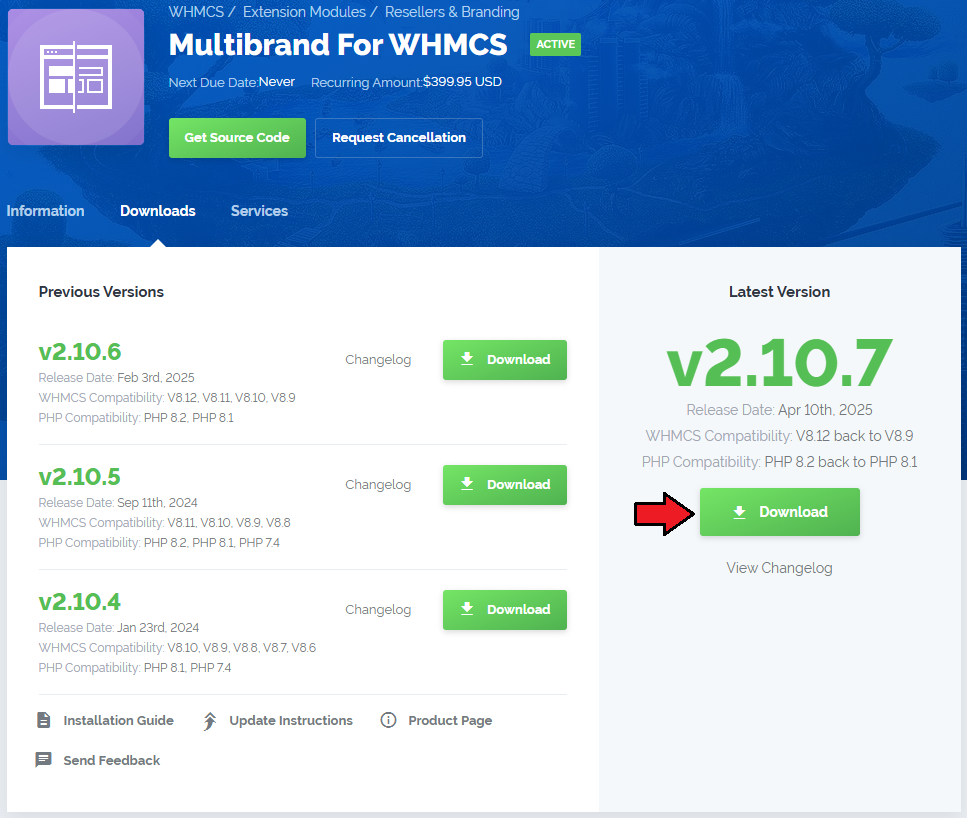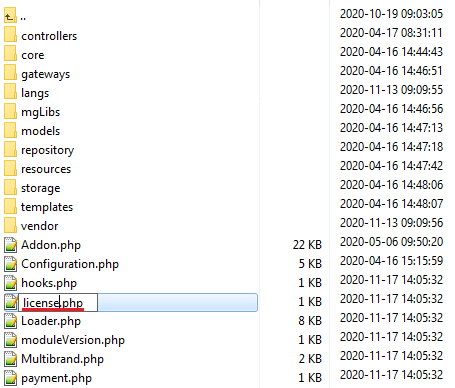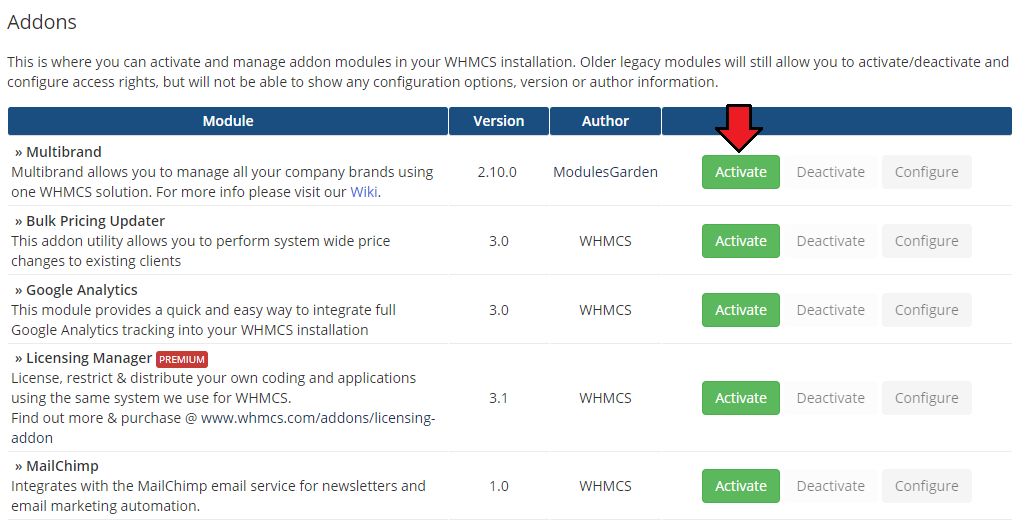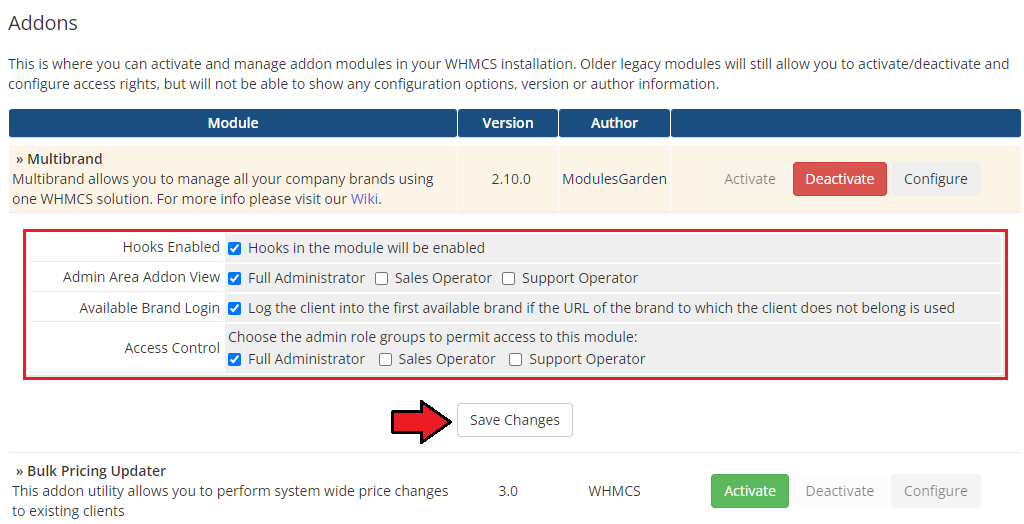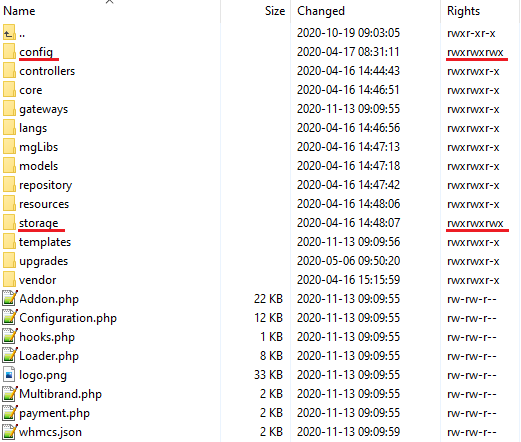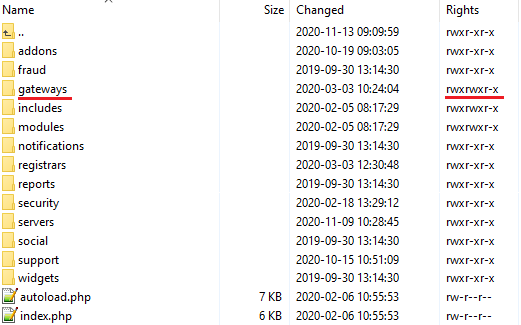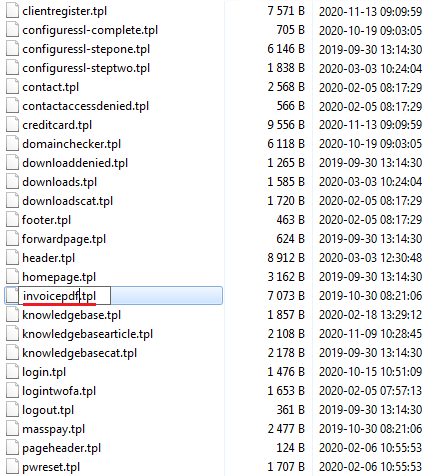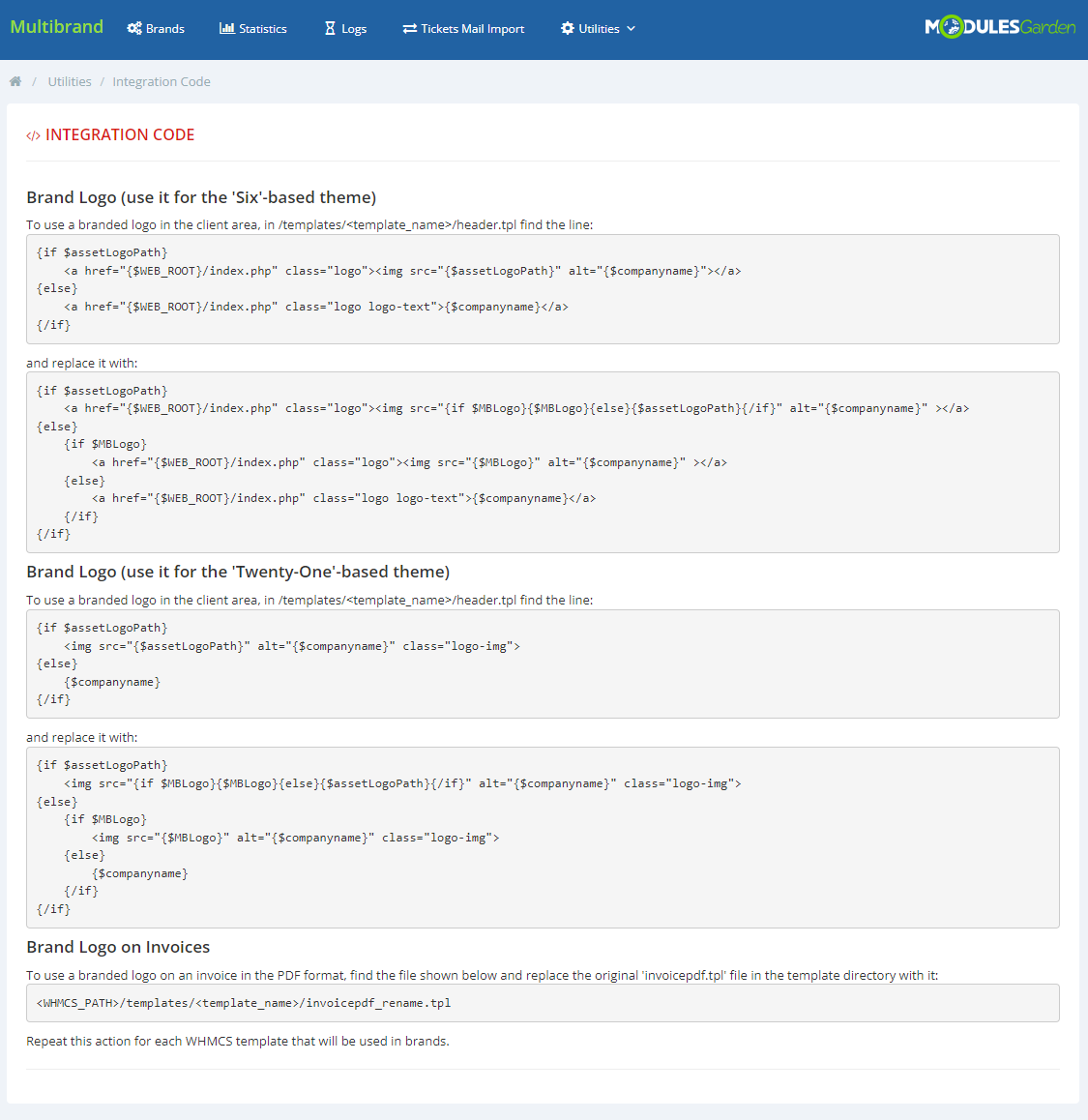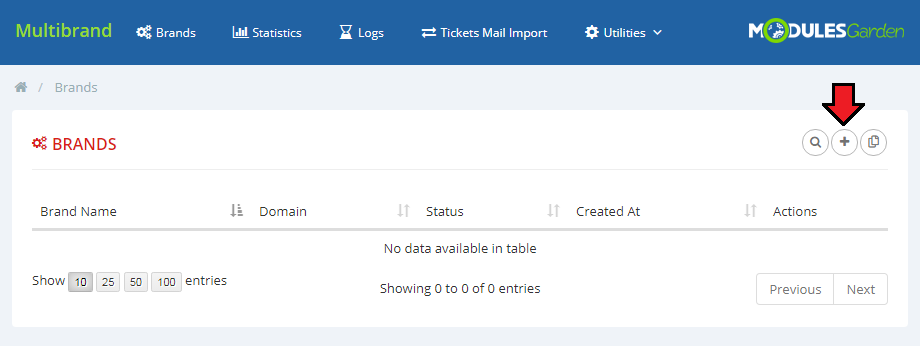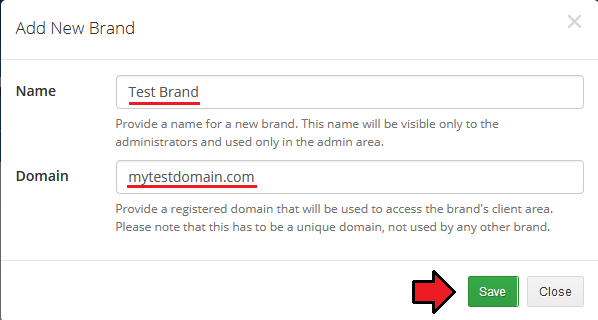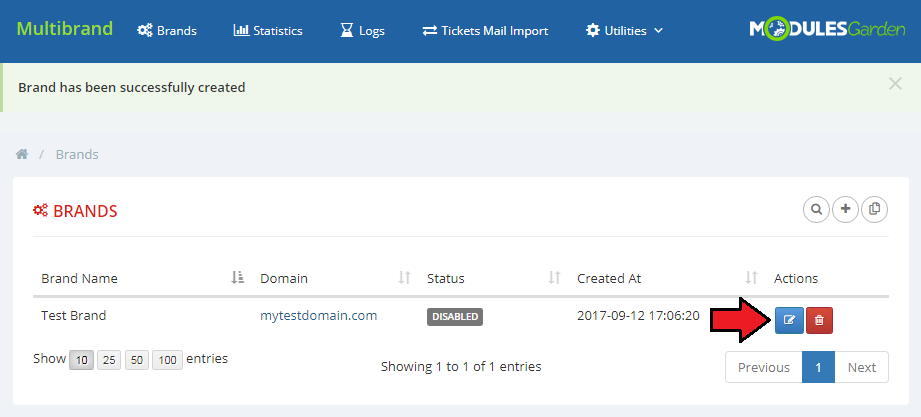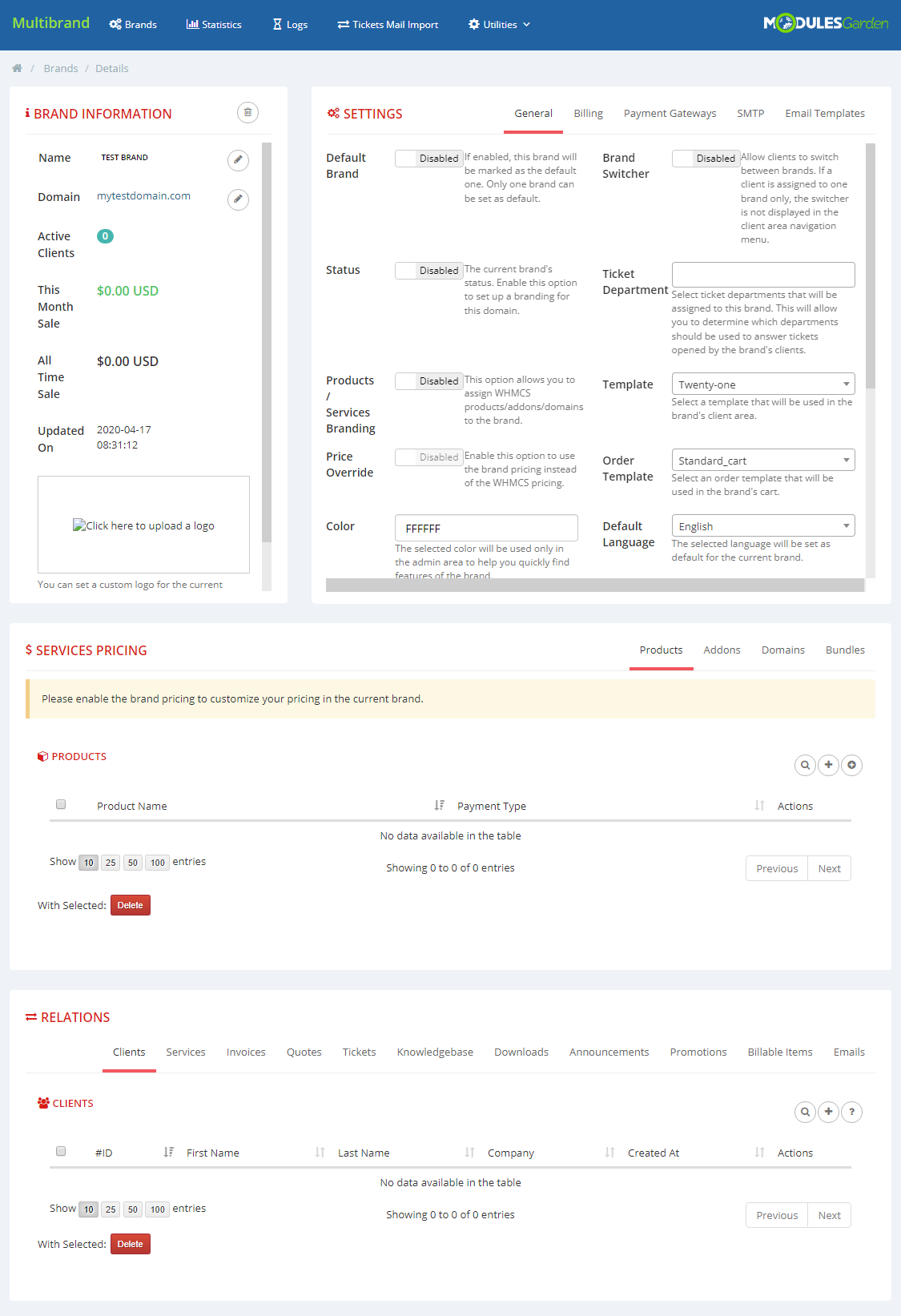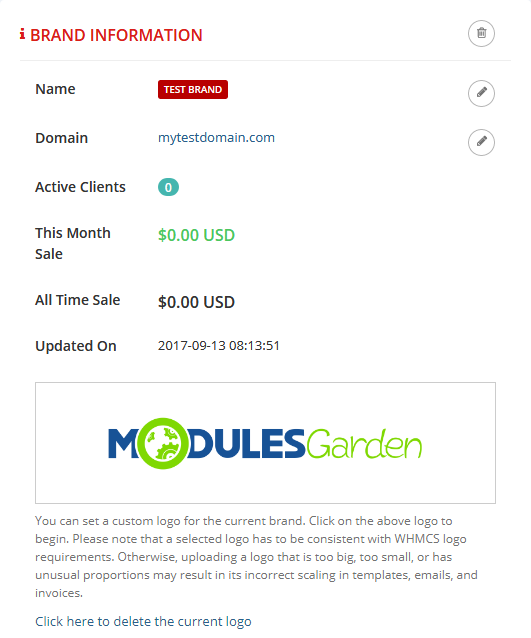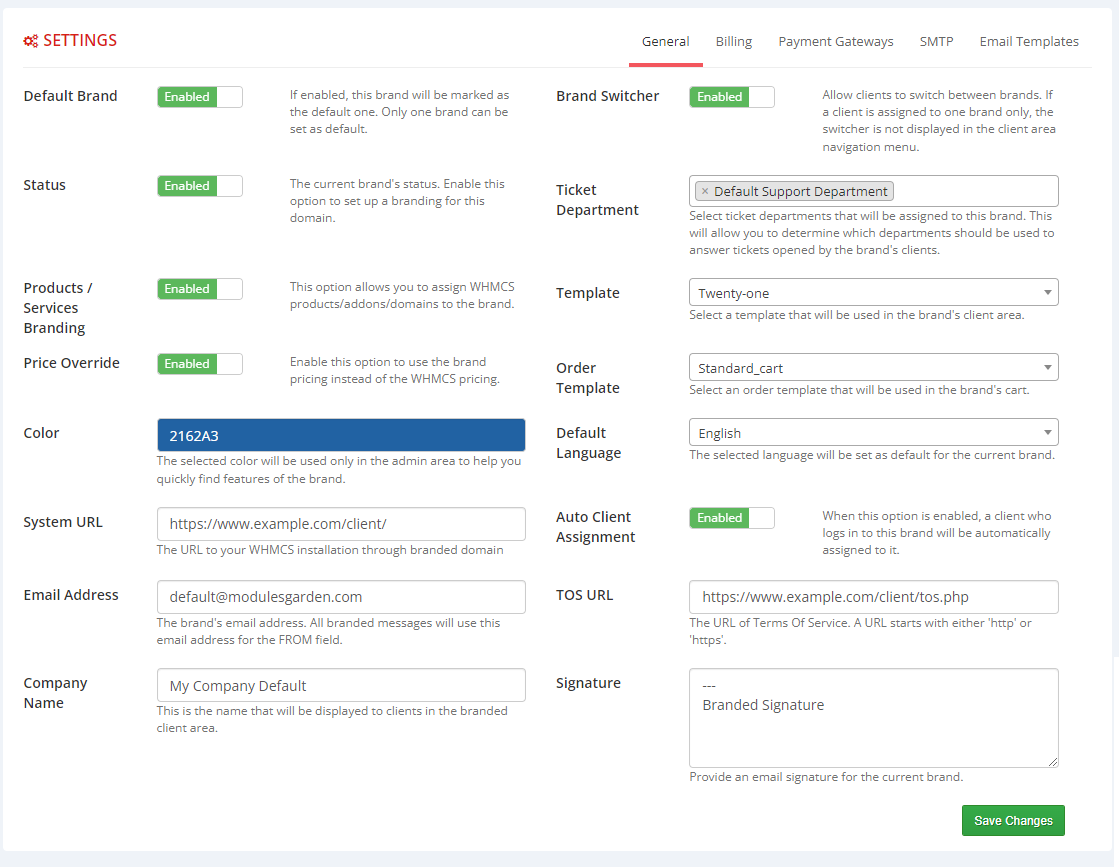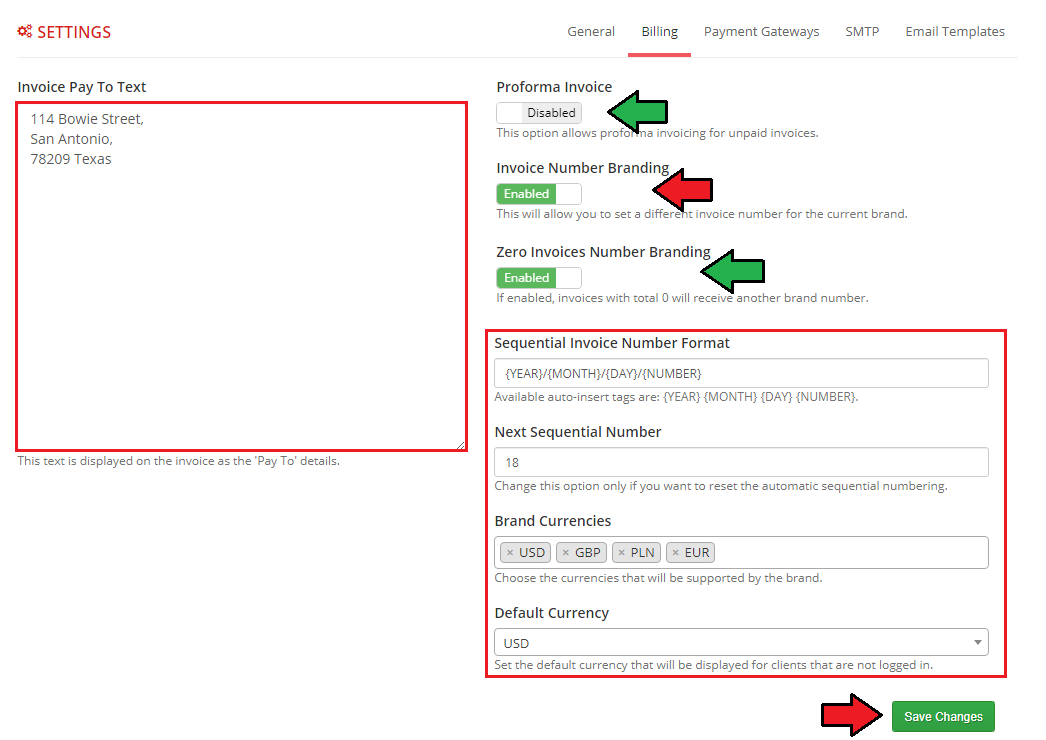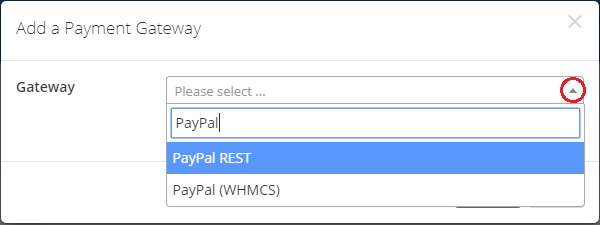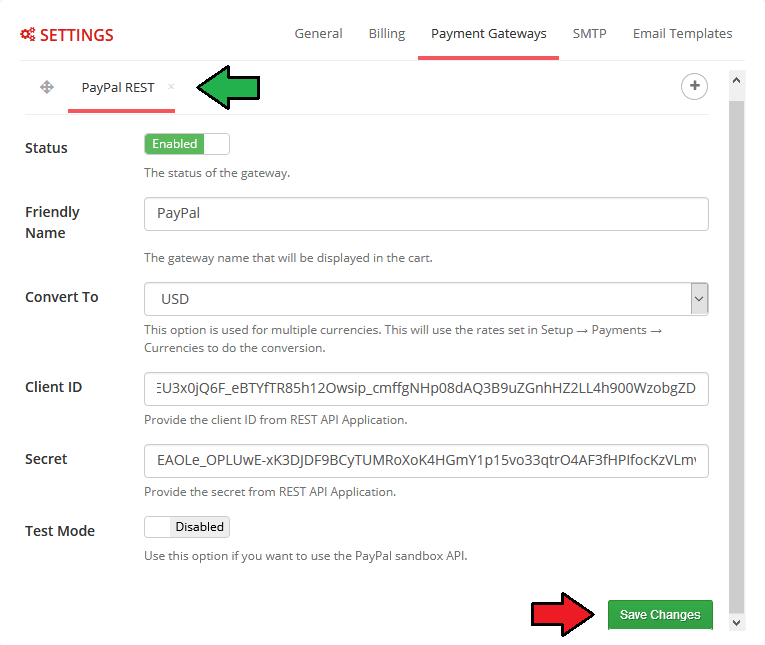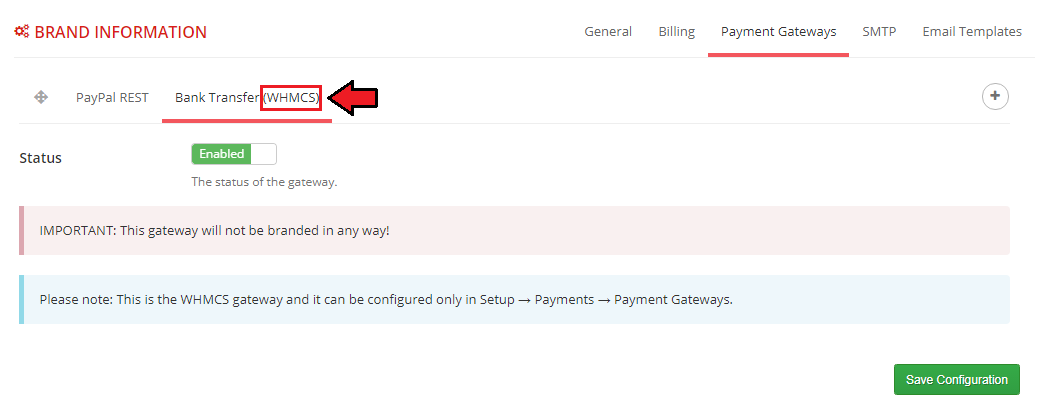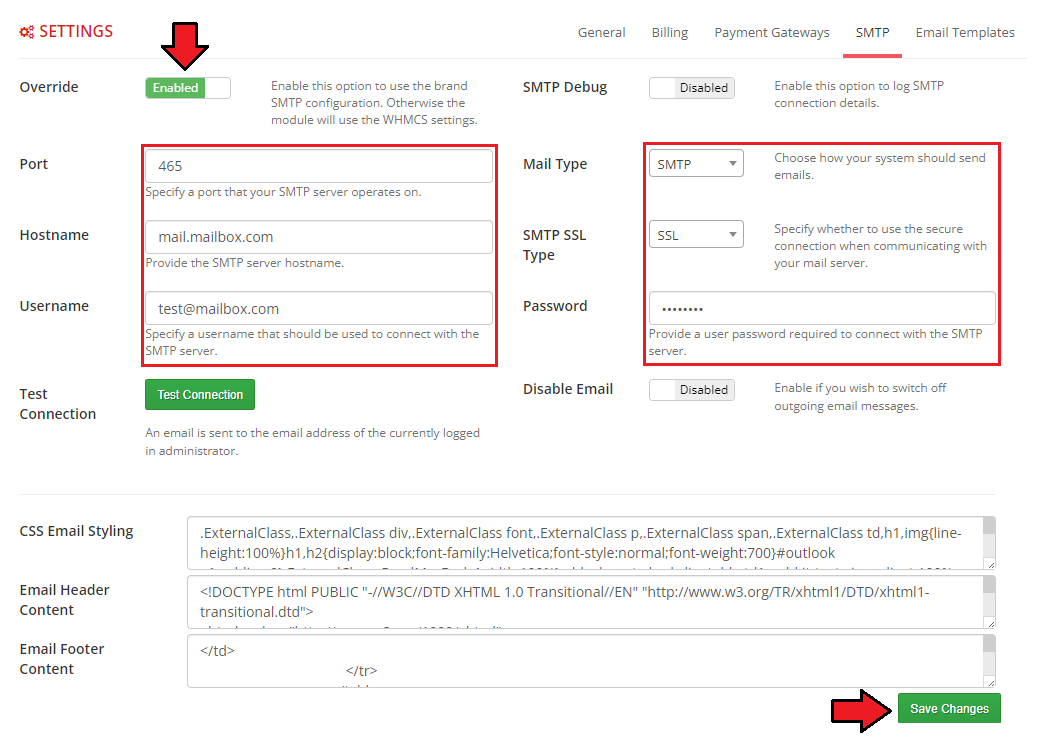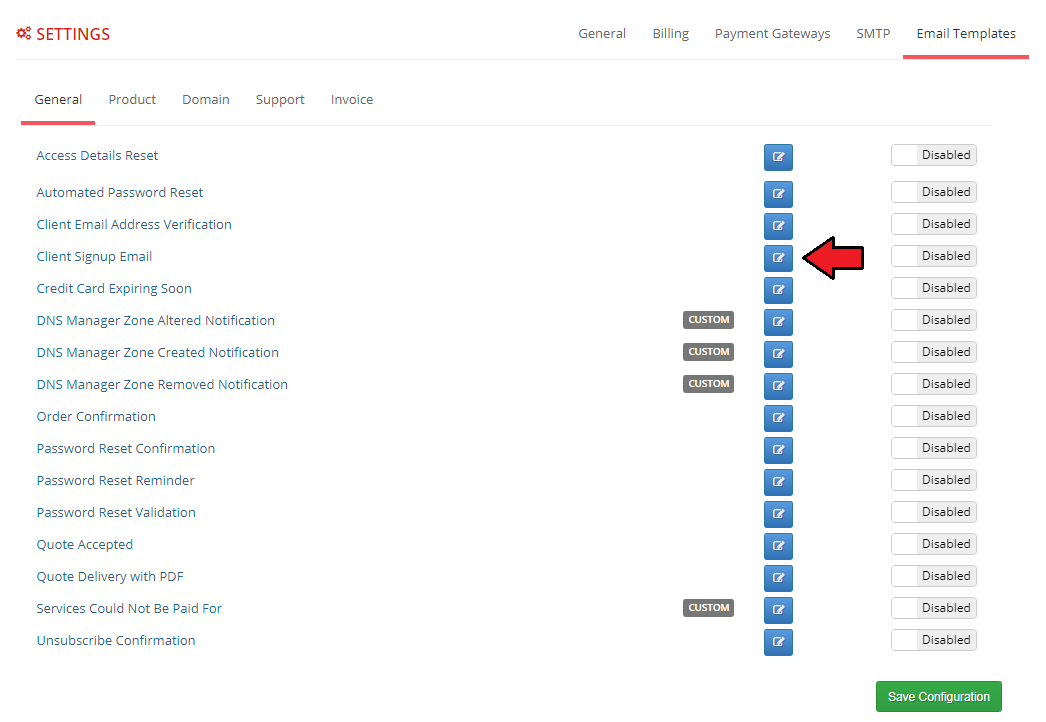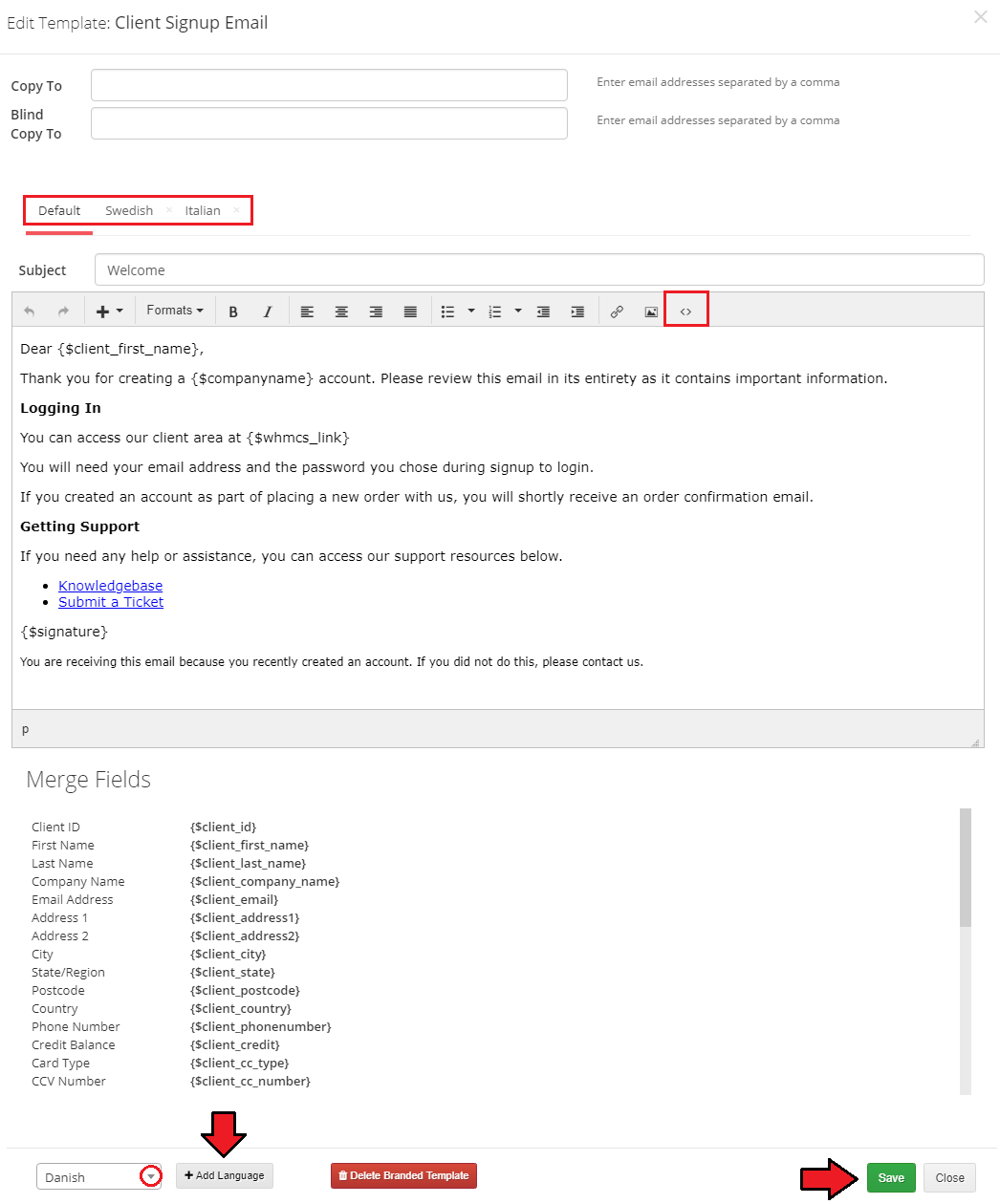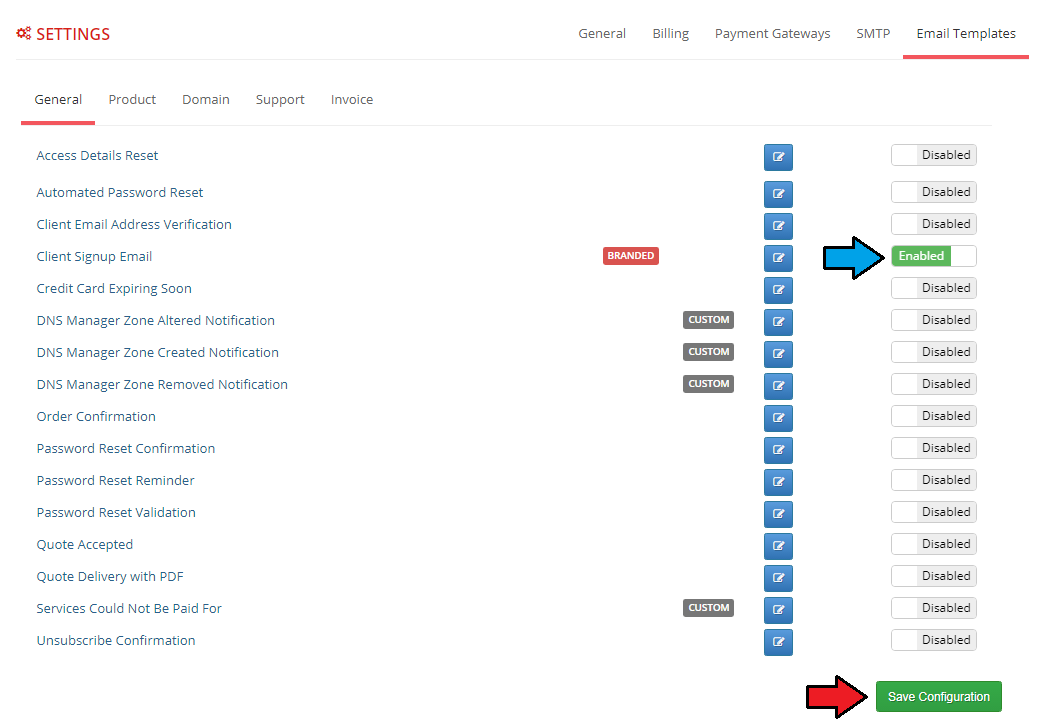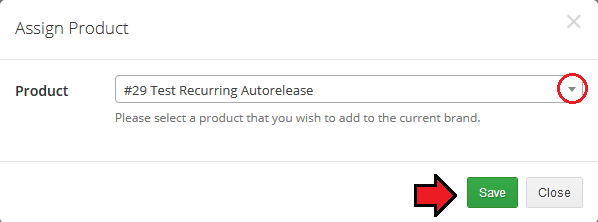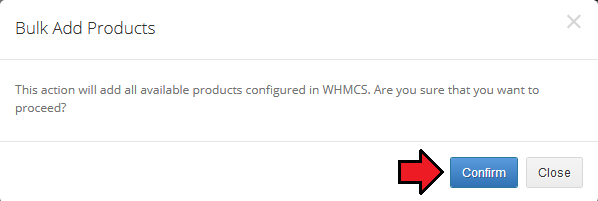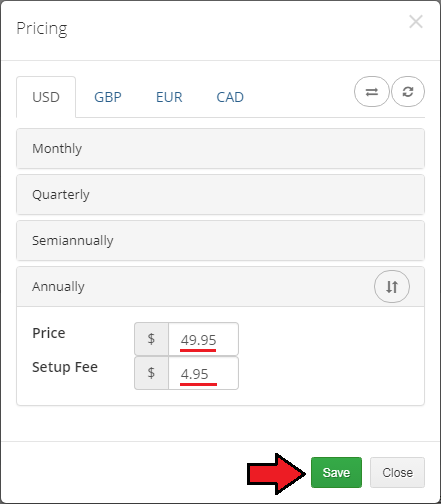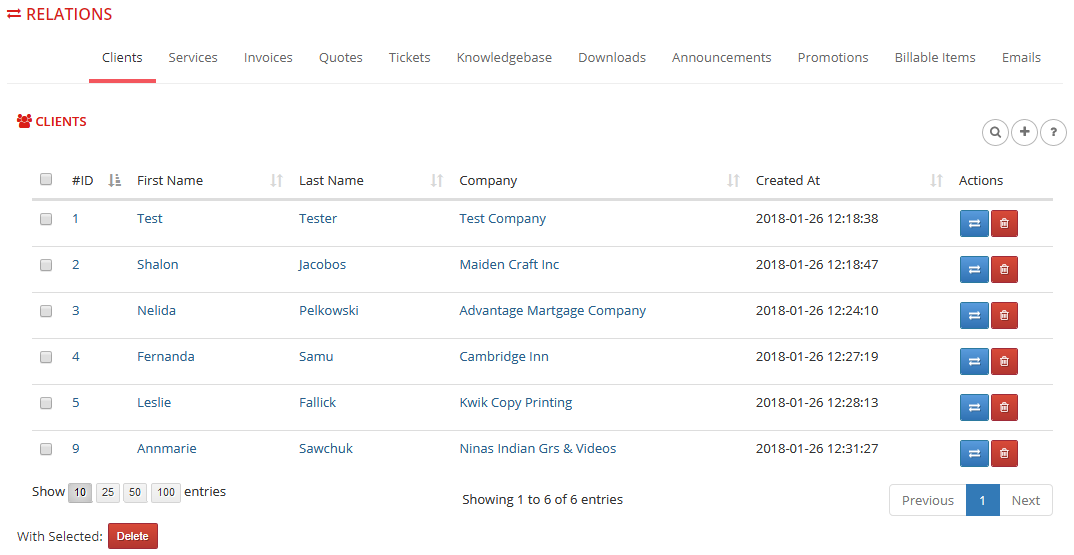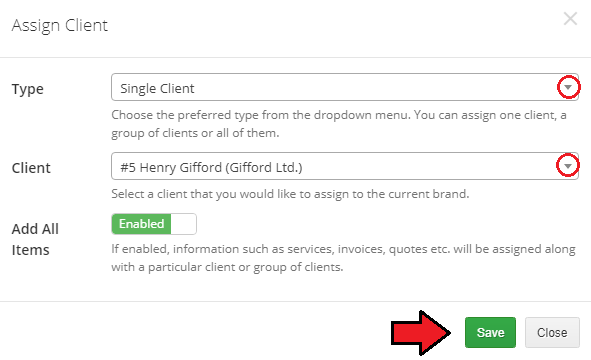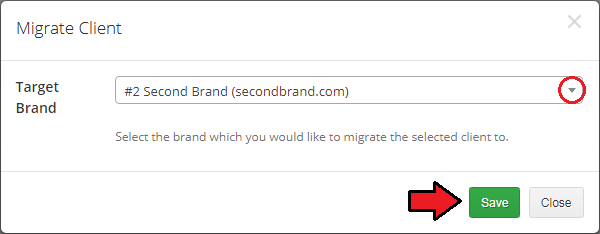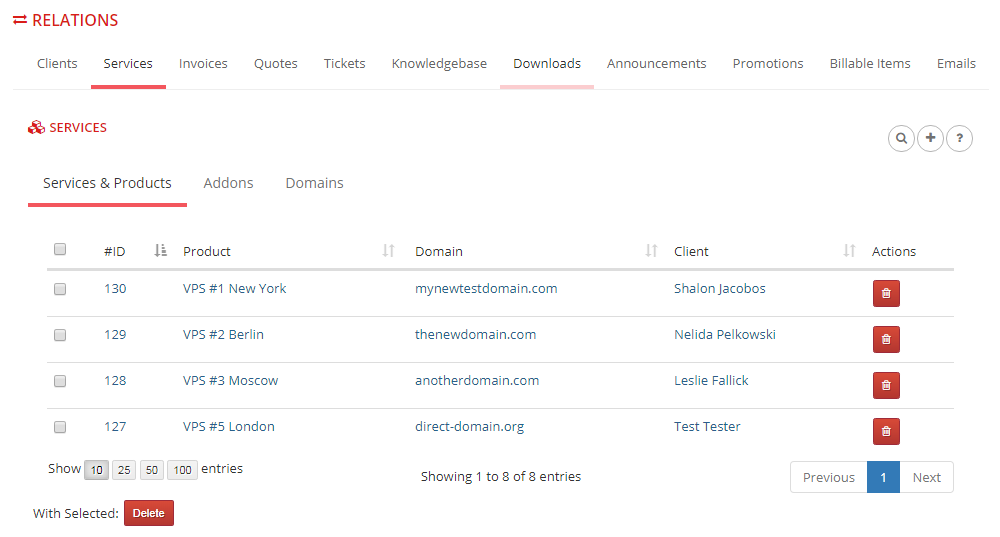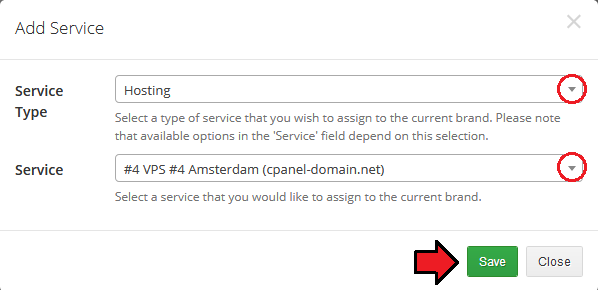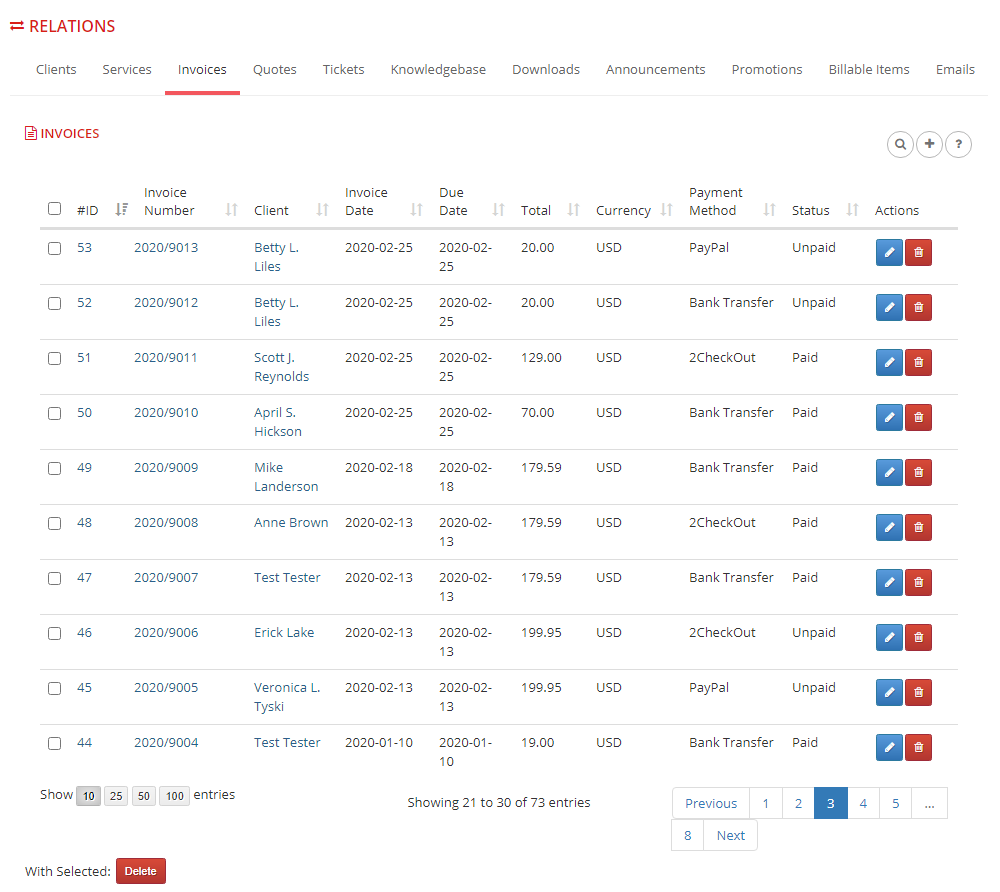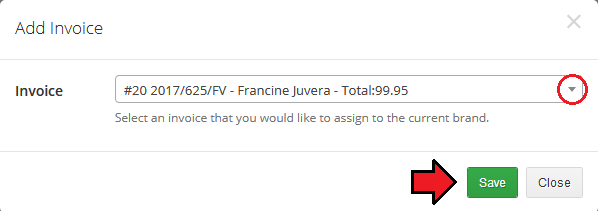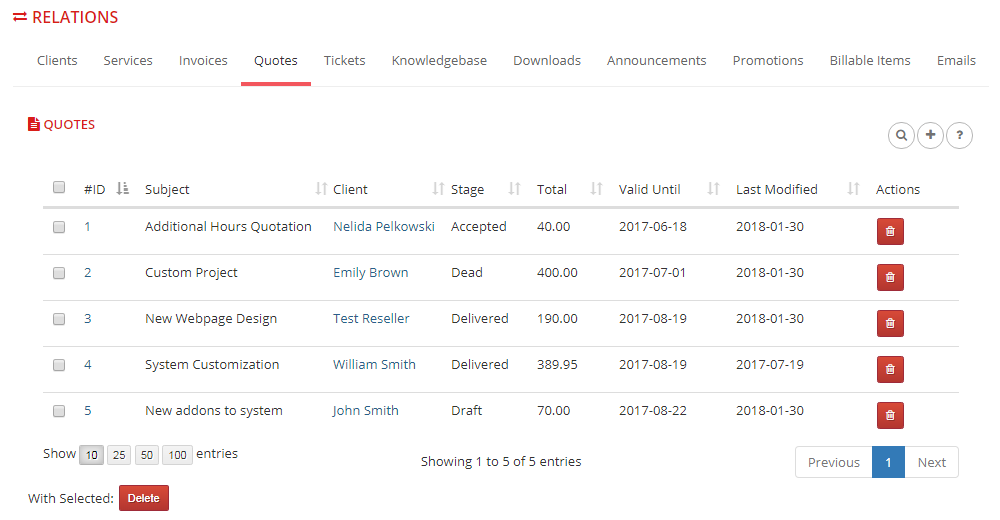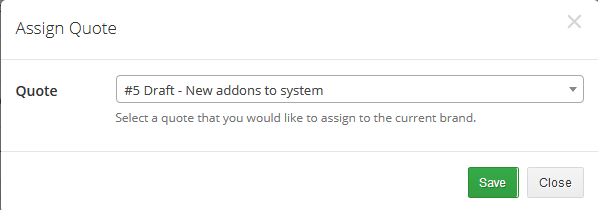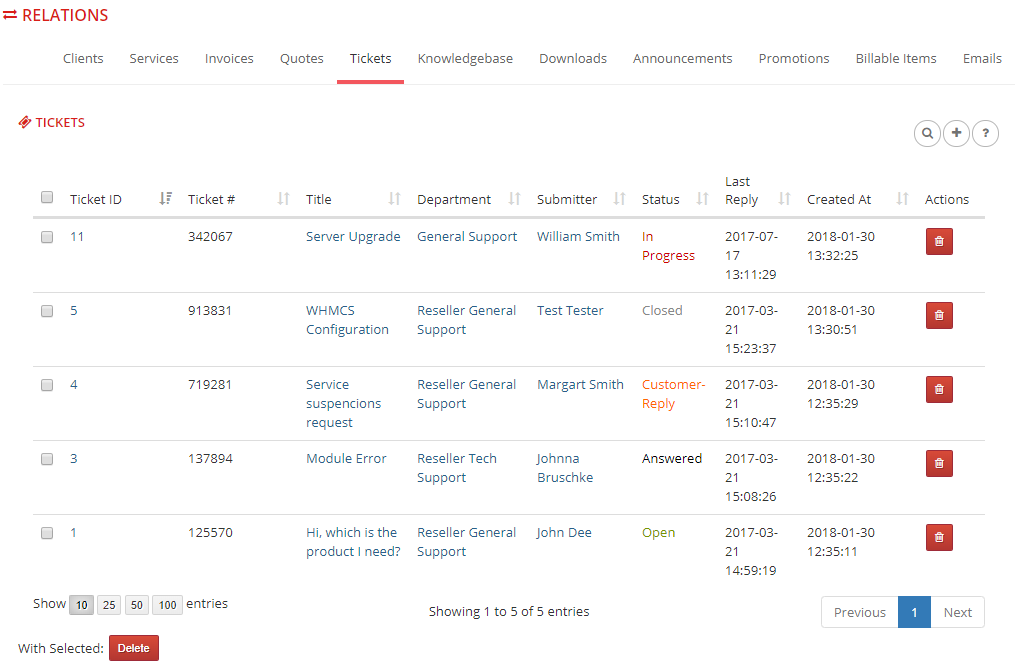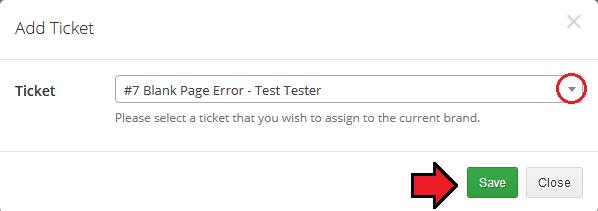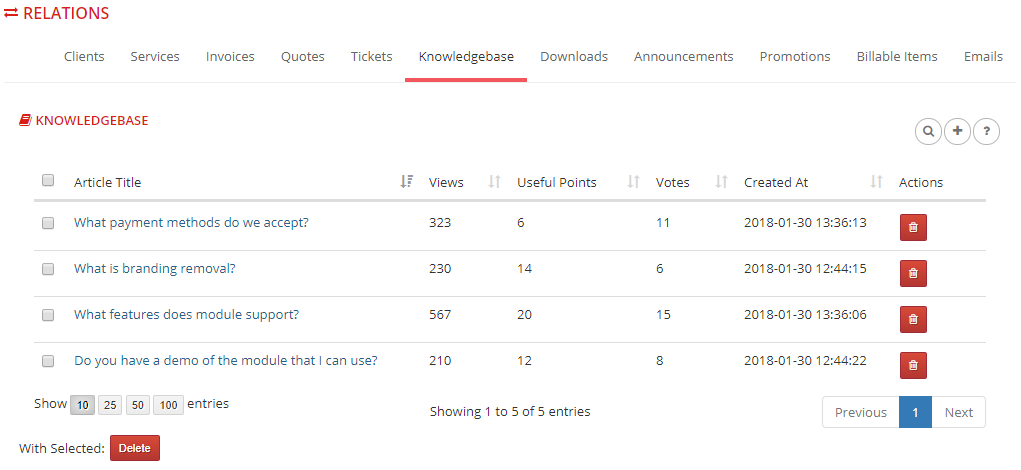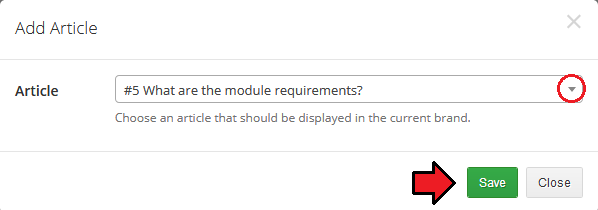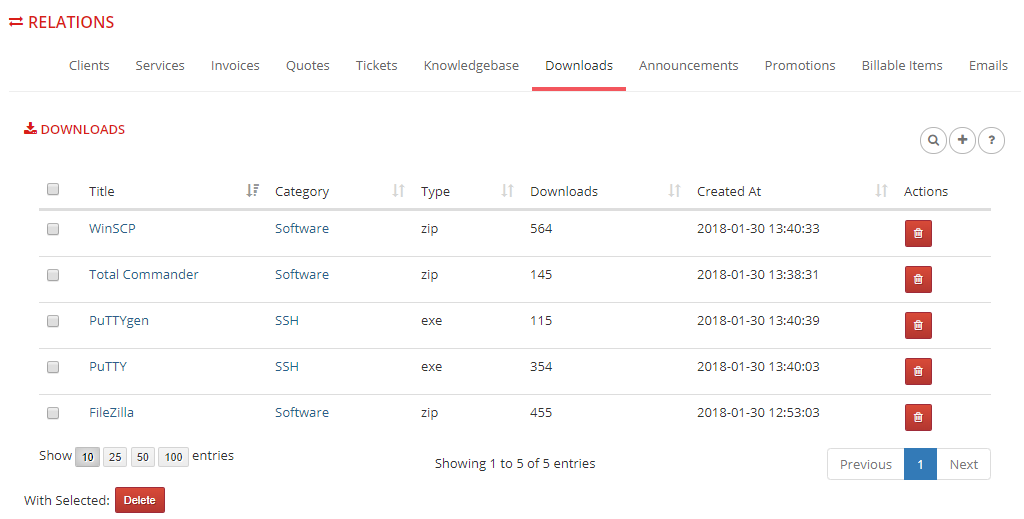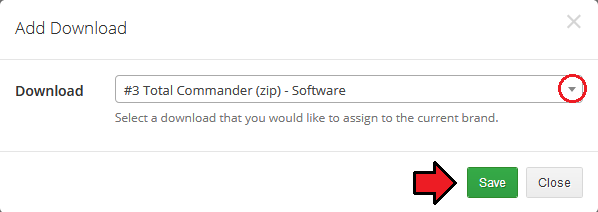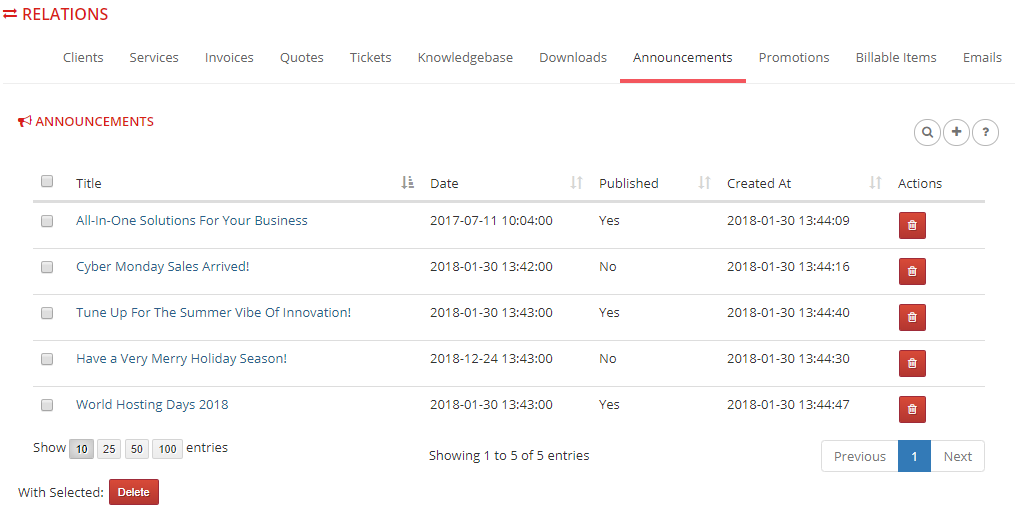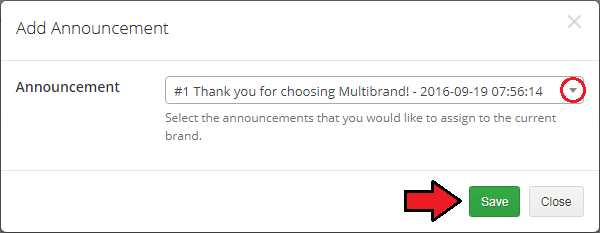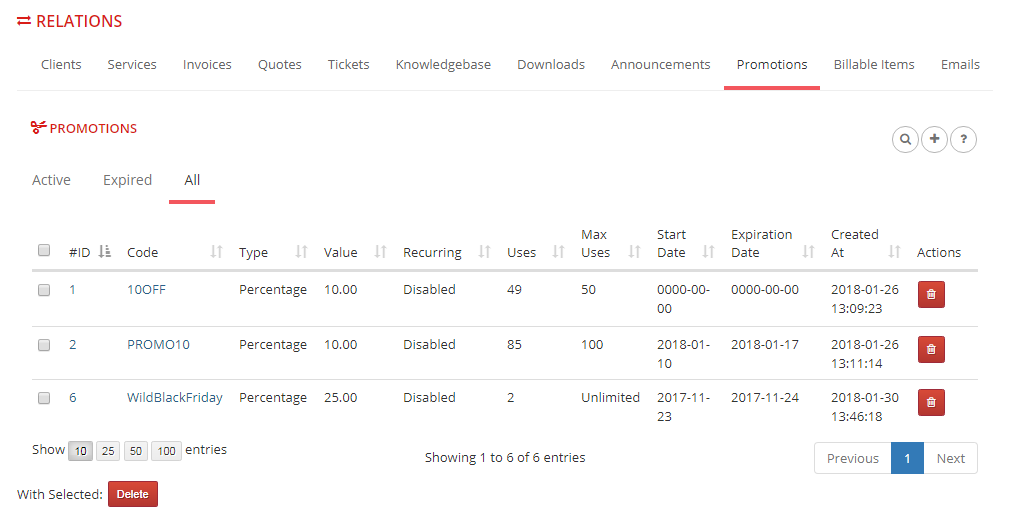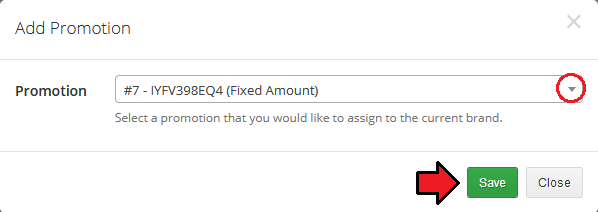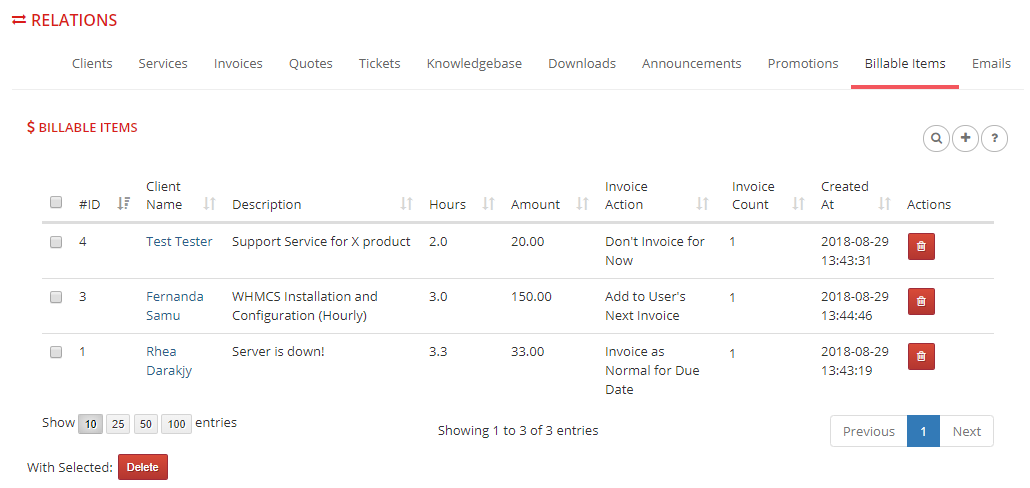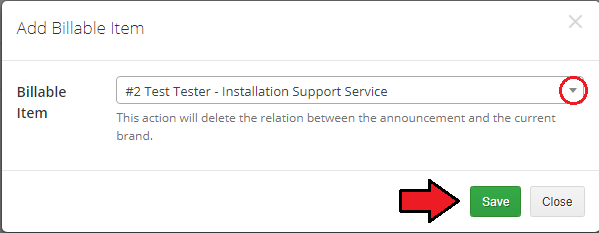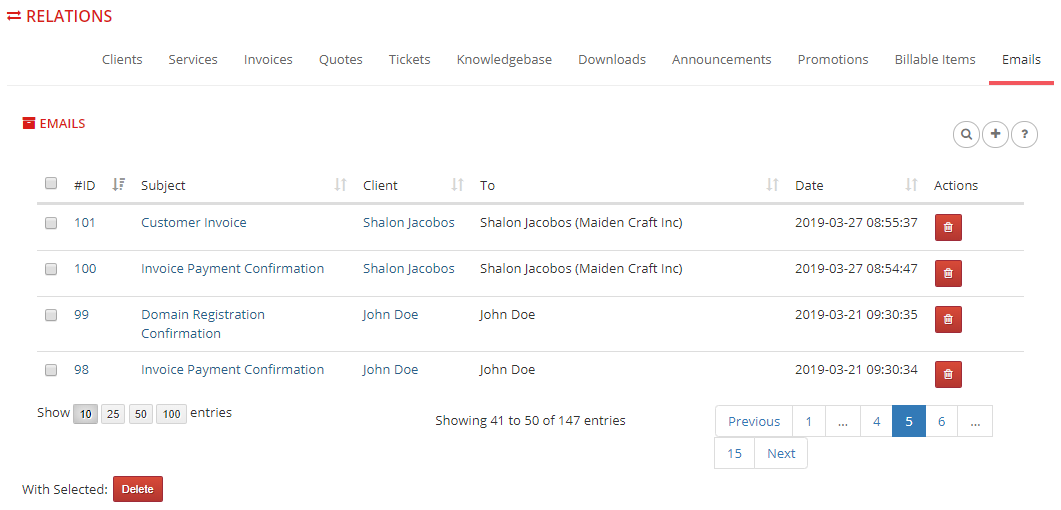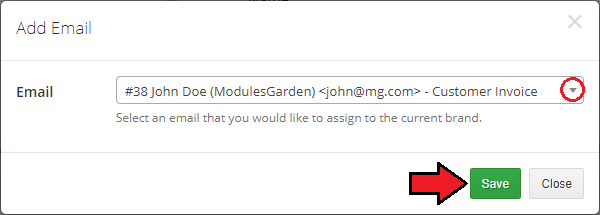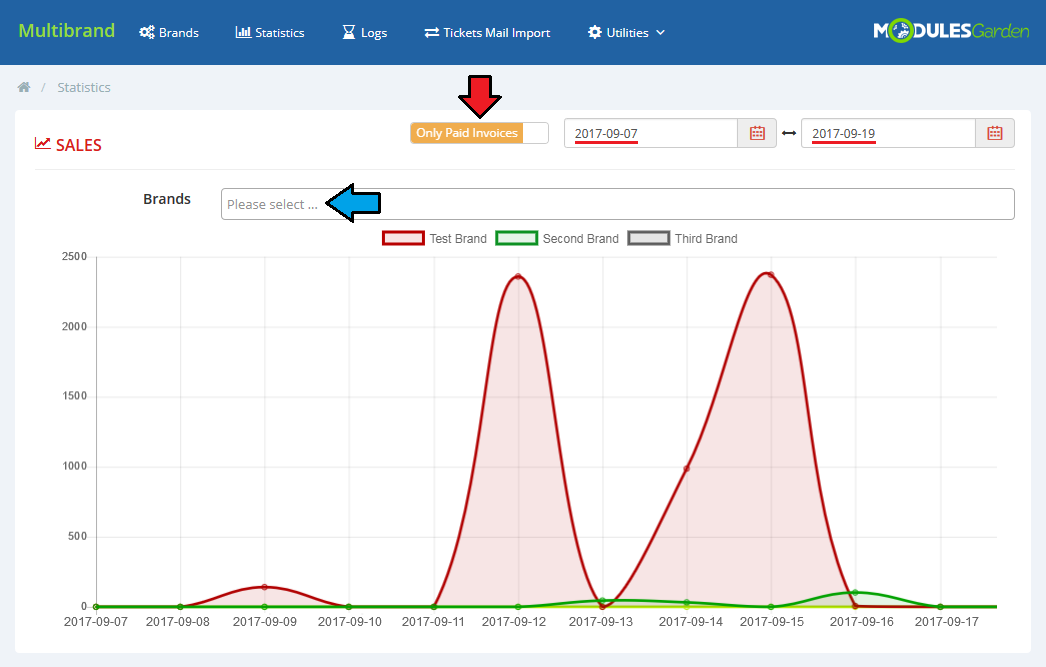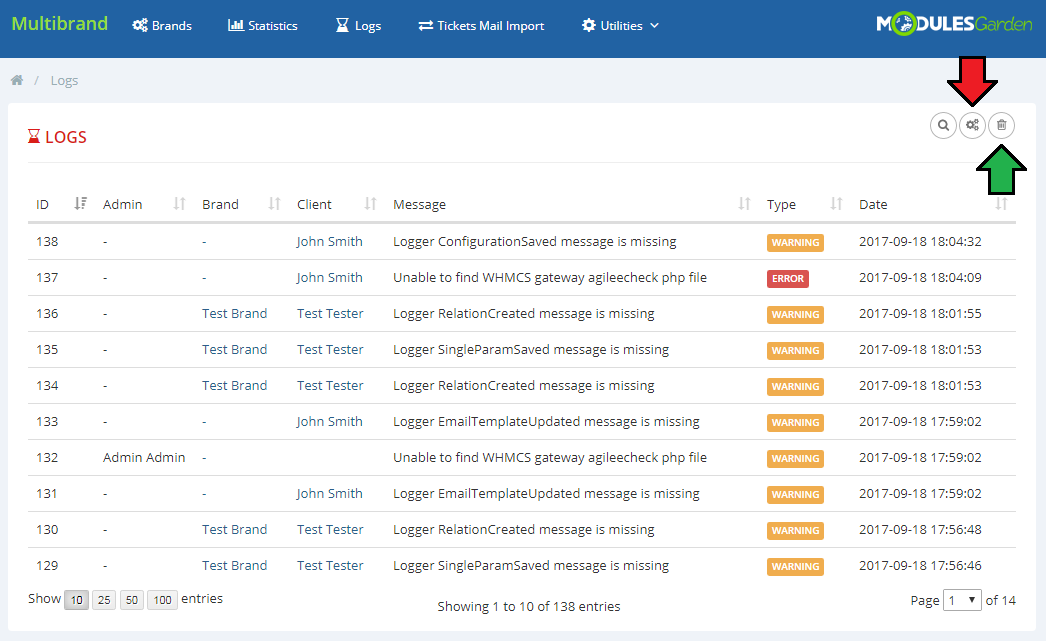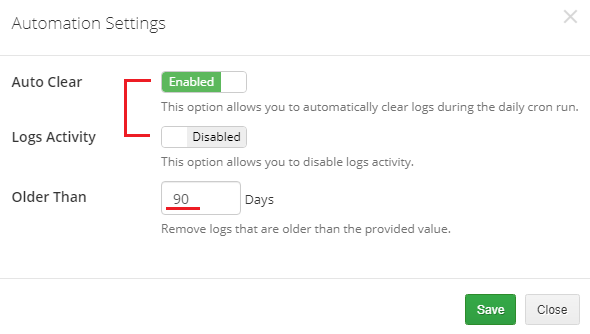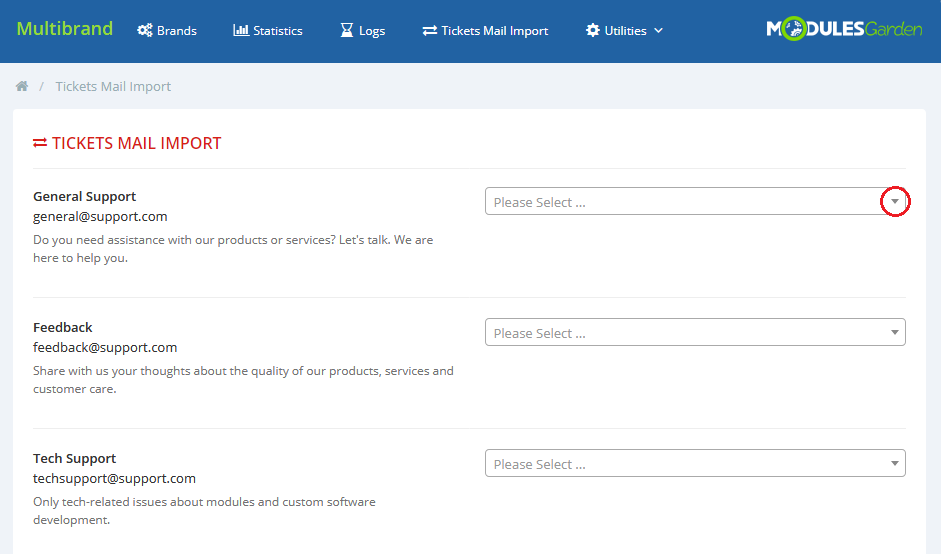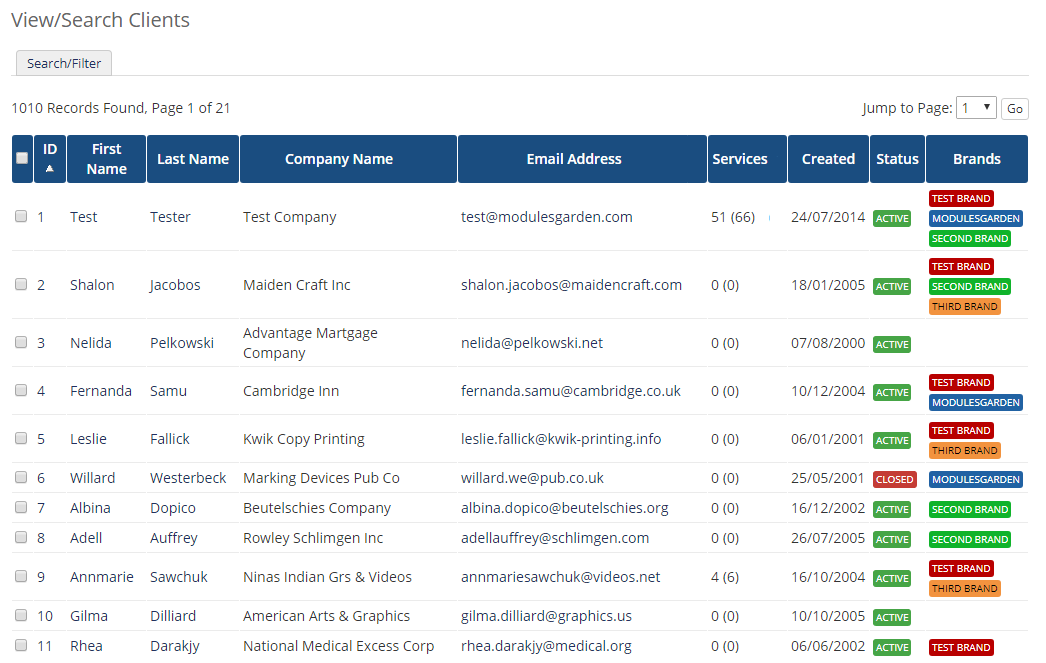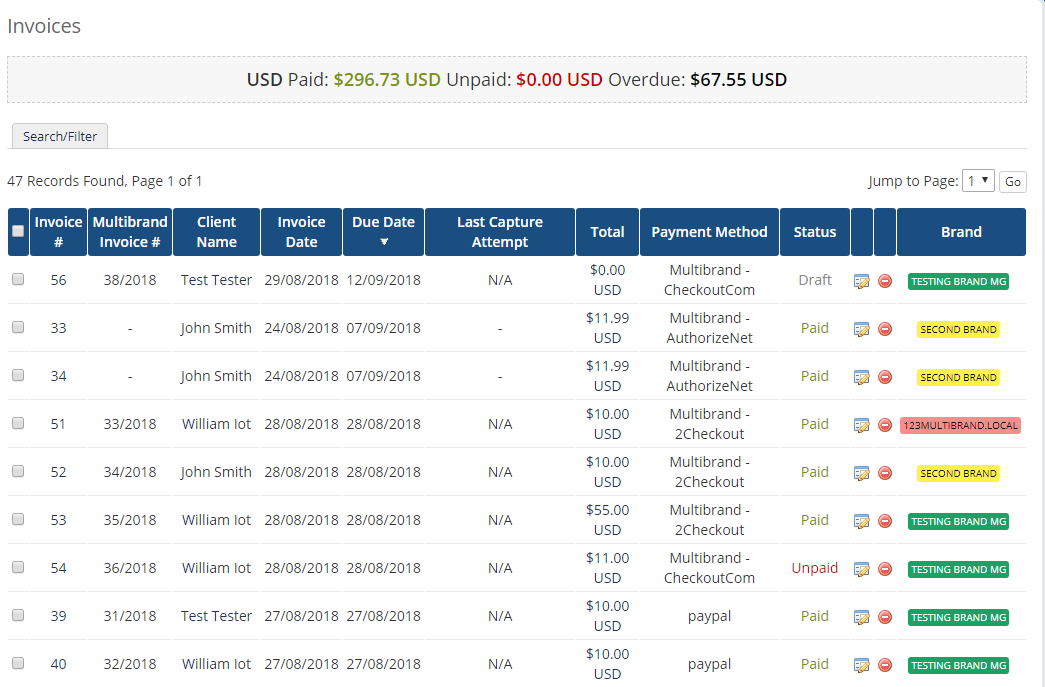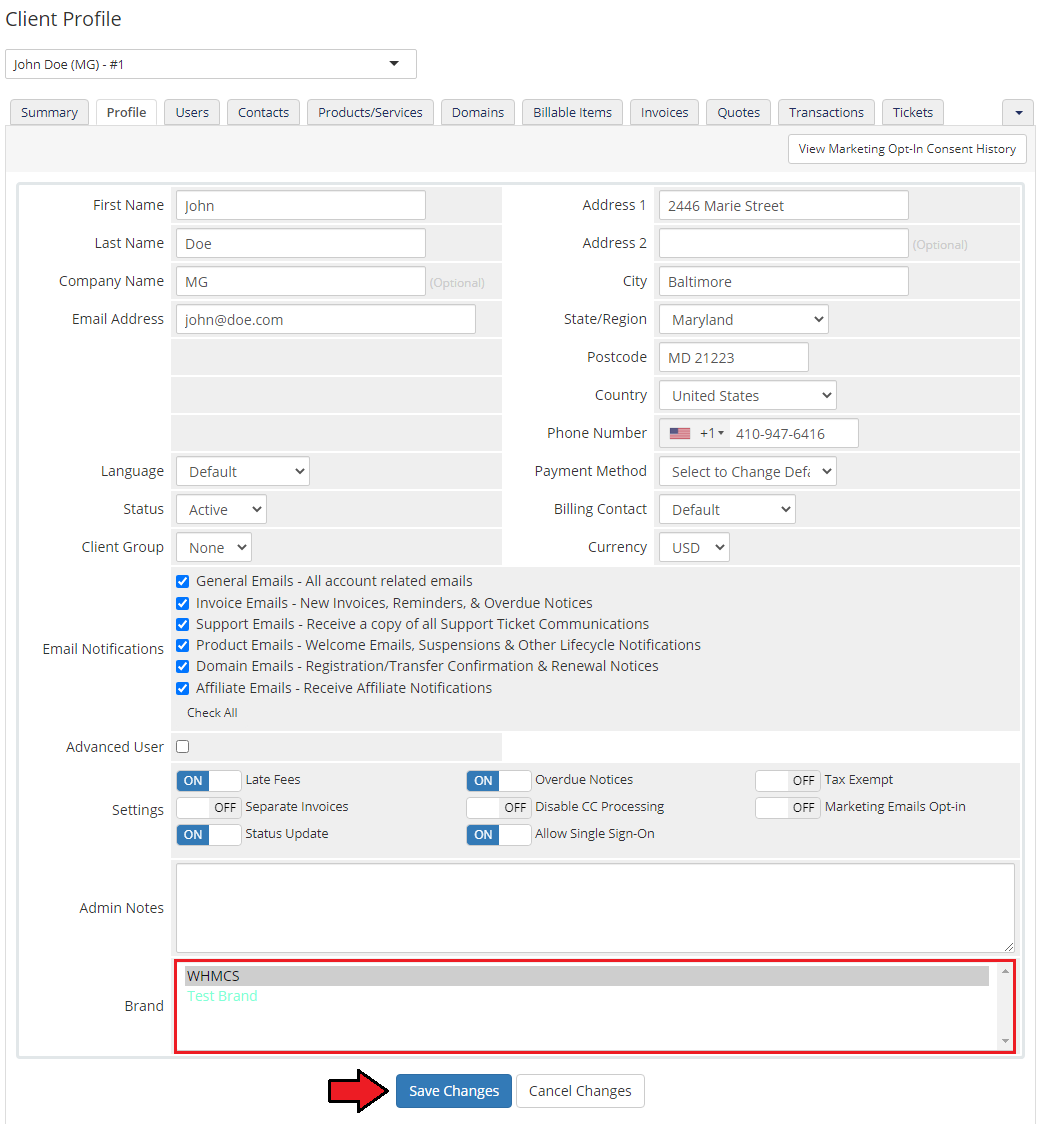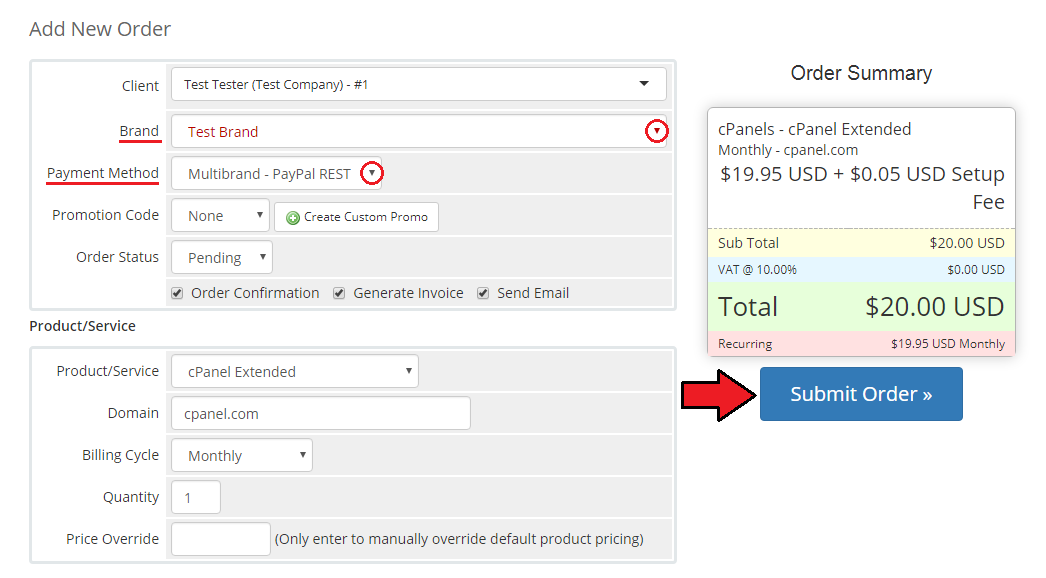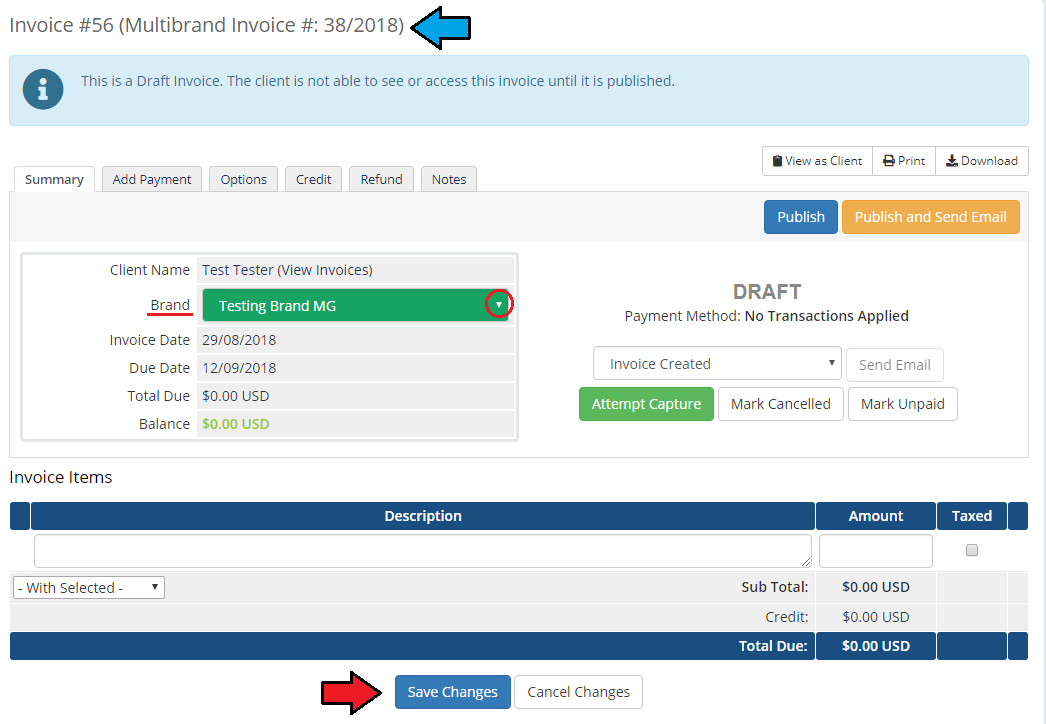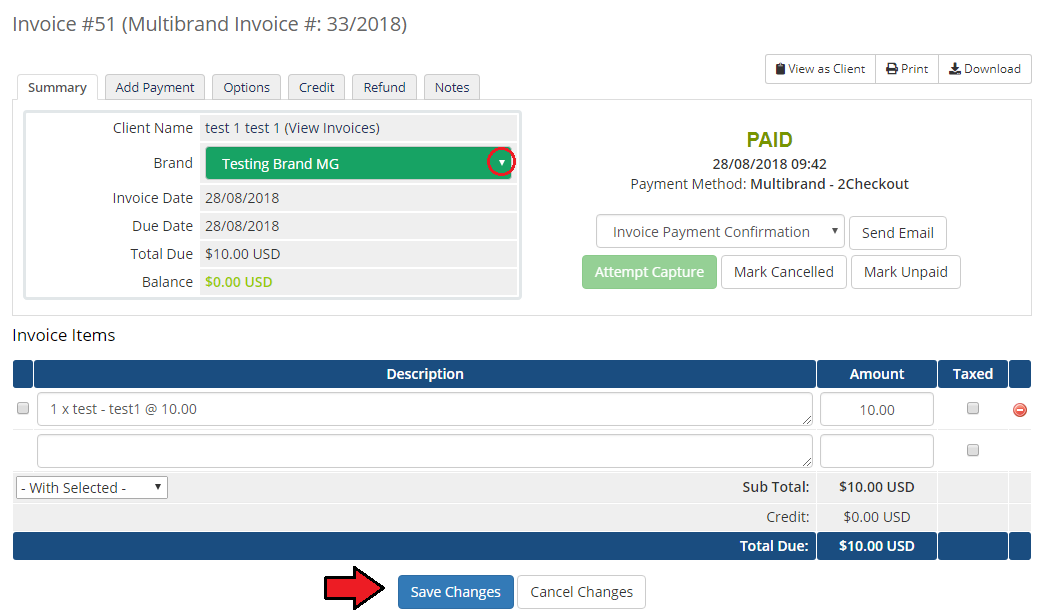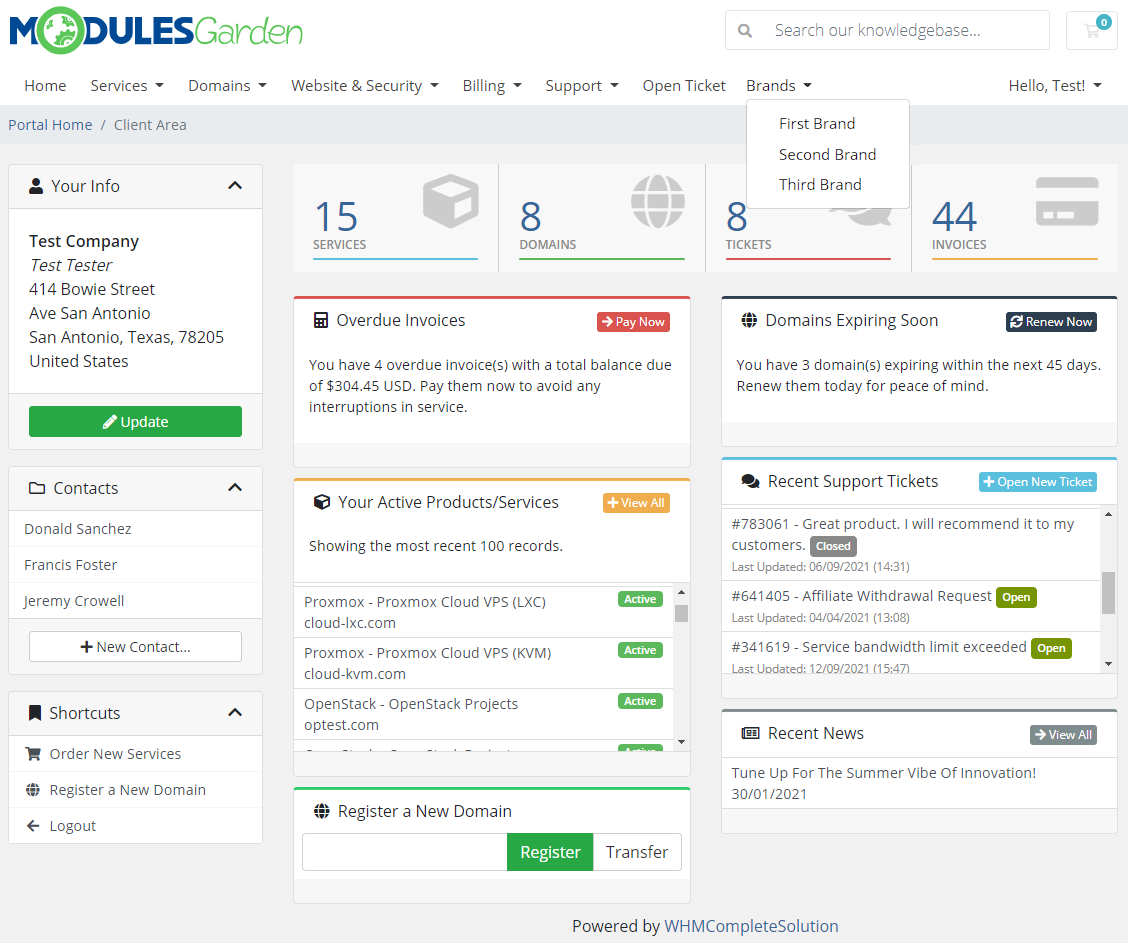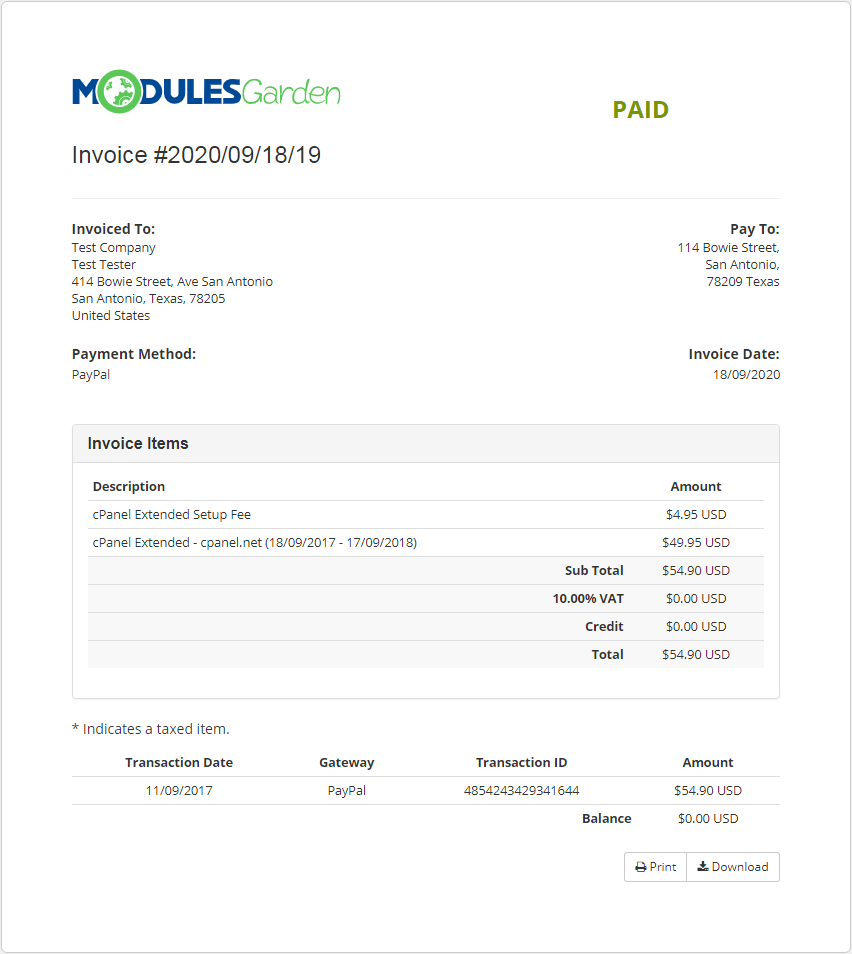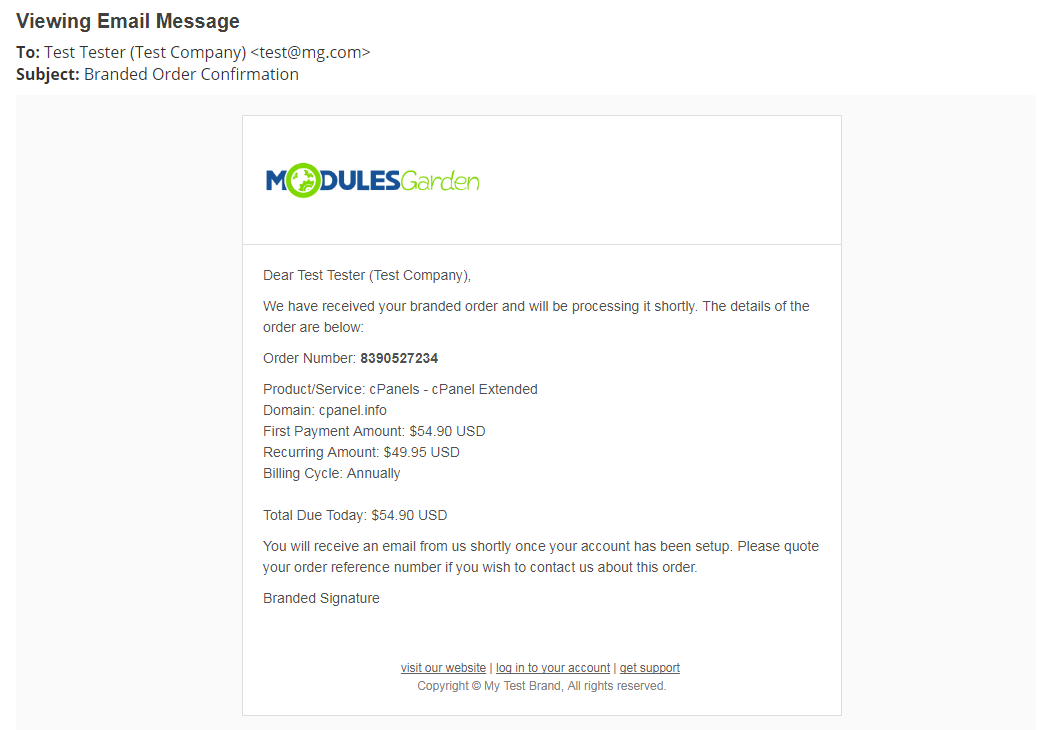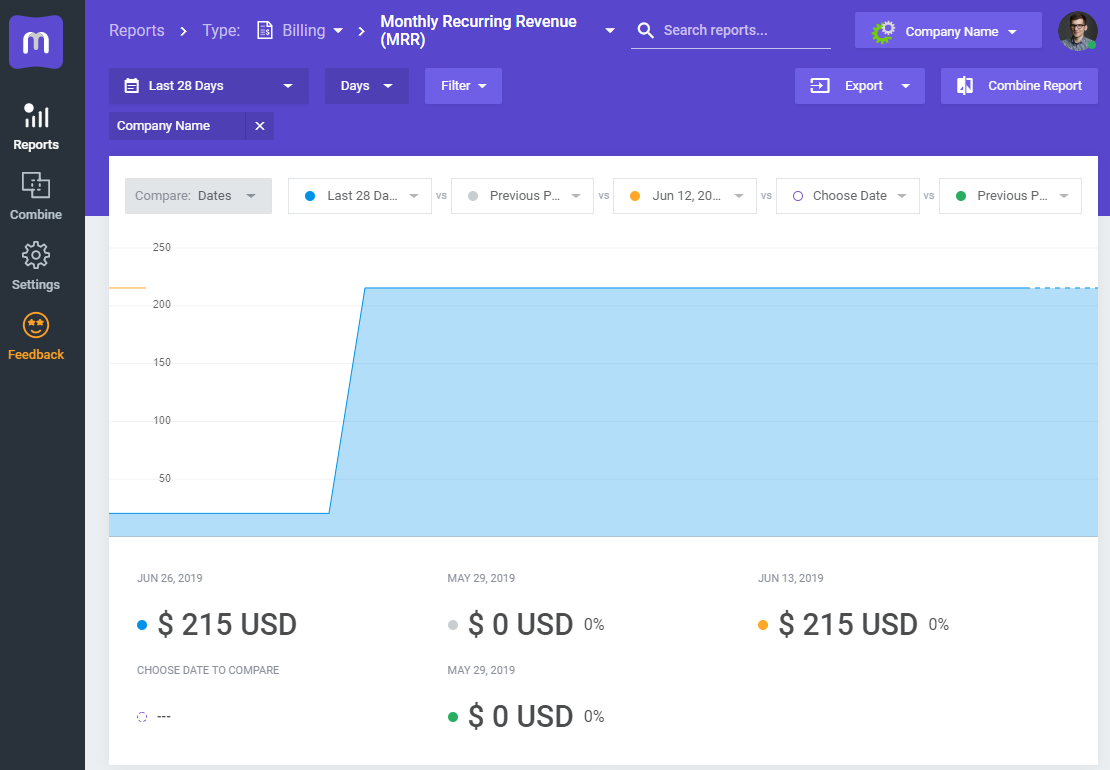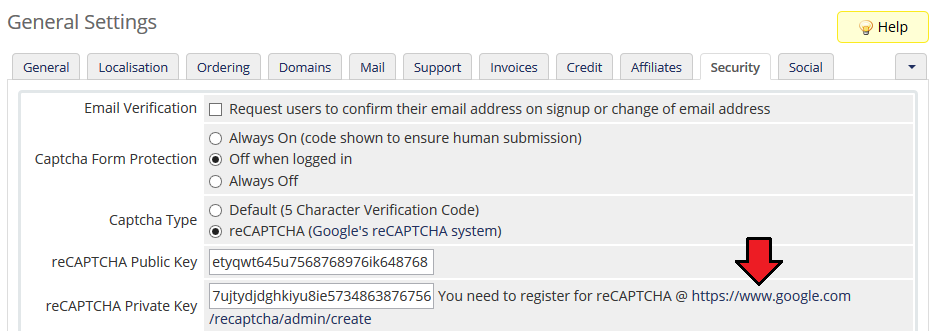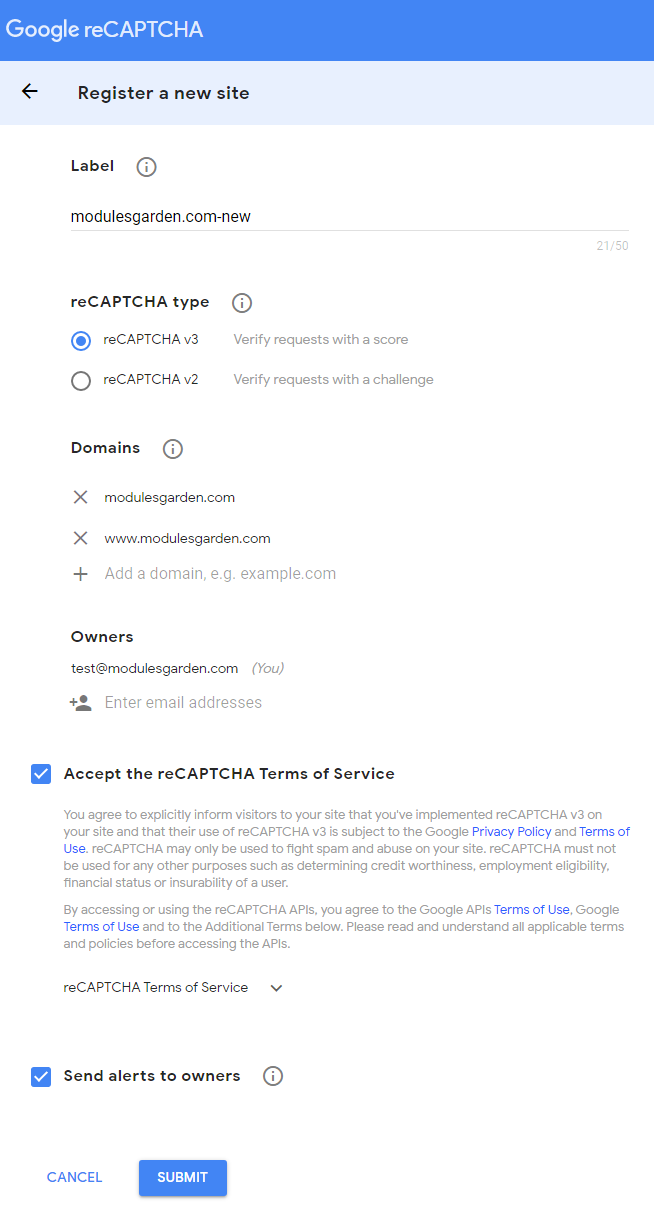Note: Please remember that the following merge fields can be used for 'Email Header Content' as well as 'Email Footer Content' .
| Company Name
|
{$company_name}
|
| Domain
|
{$company_domain}
|
| Logo URL
|
{$company_logo_url}
|
| WHMCS URL
|
{$whmcs_url}
|
| WHMCS Link
|
{$whmcs_link}
|
| Marketing Unsubscribe URL
|
{$unsubscribe_url}
|
| Marketing Optout URL
|
{$email_marketing_optout_url}
|
| Marketing Optin URL
|
{$email_marketing_optin_url}
|
| Signature
|
{$signature}
|
| Full Sending Date
|
{$date}
|
| Full Sending Time
|
{$time}
|
Email Templates
In this window you can set up each branded email template in five available categories.
- If enabled, the template configured here will be sent to the clients using the branded SMTP settings instead of the ones configured in the main WHMCS template and configuration.
- If enabled, but not configured yet, the main WHMCS template will be sent with branding applied to it.
- If disabled, the main WHMCS template will be sent using the main WHMCS SMTP configuration without any branding applied.
To start editing a branded template, simply press the 'Edit'  button. button.
|
Next, type in the email addresses to send the copy and, if needed, the blind copy to, enter the desired subject and message content. You can also create more versions, in different languages.
Additionally, along with editing the source code of a template you can use the available merge fields tags just like in the standard email templates.
Save the changes once you have finished.
|
Finally, enable the edited template and save the configuration. You will see the 'Branded' label next to the edited template.
If you would like to restore the default template, simply return to its edition and click the 'Delete Template' button.
|
Services Pricing
In this section you can configure separate prices for products, addons, domains and bundles .
Note: Remember that the 'Price Override' option has to be enabled. Otherwise, the service prices will still be taken from the main WHMCS settings.
To start, select the product, addon or domain tab and click the 'Add'  button. In the following example you will see how to add branding for product pricing. button. In the following example you will see how to add branding for product pricing.
|
| Select the product for which you want to set branded prices and click 'Save' .
|
| Or you can add all your products at once thanks to 'Bulk Action' , just press the button marked with the red arrow.
|
| Next, open the pricing editor of the chosen product.
|
Here you can configure the desired prices in selected billing cycles and currencies.
You can also automatically fill out the amounts from the main product and update them, refreshing the currencies rate.
Note: Availability of billing cycles, prices and currencies to be edited depends on their main configuration in WHMCS.
If one of them is not available for branding, it means that there is no corresponding configuration in the main WHMCS.
|
| From now on, the pricing for this product will be branded. You can also configure pricing for addons and domains in the same way.
|
Relations
In this section you can see which Clients, Services, Invoices, Quotes, Tickets, Knowledgebase, Downloads, Announcements, Promotions, Billable Items and Emails are assigned to this brand.
In addition, you can manually manage, assign and unassign selected items to the brand.
Do not forget to check the 'Branded Admin Area Functionalities' section, where you will find more brand relation management functionality outside the Multibrand addon.
Note: Currently there is no option of mass management, assigning and unassigning selected items to the brand. This functionality is planned to be implemented in future releases.
Additionally, if you would like to change any relation between brands, remember that first you have to unassign (delete) that relation from the previous brand, and only then can you add that relation to the second brand.
Otherwise, the changed item might not appear in the search box of the added relation.
|
Clients
In the 'Clients' tab you can see customers who are assigned to the brand and the date on which they were assigned.
Assignment takes place at the moment of client's registration for the branded domain. You can also manually assign the already existing customers to the brand or migrate them to another.
Note: If the 'Auto Client Assign' option is enabled, then the customers who are already registered in one of the brands and try to log in to another brand will also be automatically assigned to it.
Therefore, one customer can be assigned to several brands at the same time.
|
To assign an existing client to the brand, press the 'Add'  button. button.
- Type - decide if you want to assign a single client, groups of clients or all of your clients. Choose the preferred option from the dropwdown menu.
- Add All Items - enable if you want to assign services, invoices, quotes, tickets etc. along with your client or groups of clients.
Do not forget to click 'Save' .
|
You can also migrate the customers from this brand to another one.
Click on the 'Migrate'  button next to the client and then select the brand to which you want to assign this client. button next to the client and then select the brand to which you want to assign this client.
|
And finally, if you want to delete a customer's relationship with this brand, click the 'Delete'  button or choose several items to be removed at once button or choose several items to be removed at once  and confirm the action. and confirm the action.
|
Services
In the 'Services' tab you can see which Services & Products, Addons and Domains have a relation with this brand.
These are automatically added to the brand while ordering from the branded domain.
|
You can also manually add a relation for a service that is not branded yet.
Press the 'Add'  button and then select a type and service you want to assign to the brand. button and then select a type and service you want to assign to the brand.
|
Again, if you want to delete a service relation with the brand, press 'Delete'  button or choose several items to be removed at once button or choose several items to be removed at once  and confirm the action. and confirm the action.
|
Invoices
In this tab you can see which invoices have a relation with your brand.
These invoices are automatically added to the brand after an order has been created from the branded domain.
|
You can also manually add a relation for the invoice that is not branded yet.
Press 'Add'  and select an invoice you want to assign to the brand. and select an invoice you want to assign to the brand.
|
If you want to delete an invoice relation with the brand, press the 'Delete'  button or choose several items to be removed at once button or choose several items to be removed at once  and confirm the action. and confirm the action.
|
Quotes
In this tab you can see which quotes have a relation with your brand.
These are automatically added to the brand after an order has been created from the branded domain.
|
You can also manually add a relation for the quote that is not branded yet.
Press 'Add'  and select a quote you want to assign to the brand. and select a quote you want to assign to the brand.
|
If you want to delete a quote relation with the brand, press the 'Delete'  button or choose several items to be removed at once button or choose several items to be removed at once  and confirm the action. and confirm the action.
|
Tickets
In this tab you can see which tickets have a relation with the brand.
These tickets are automatically branded after a ticket has been opened in one of the earlier branded departments.
|
You can also manually add a relation for the ticket that is not branded yet.
Click on 'Add'  and select the ticket you want to assign to the brand. and select the ticket you want to assign to the brand.
|
If you want to delete a ticket relation with the brand, press the 'Delete'  button or choose several items to be removed at once button or choose several items to be removed at once  and confirm the action. and confirm the action.
|
Knowledgebase
In this tab you can see which of your knowledgebase articles have a relation with the brand.
In addition, here you can find various statistics of views, useful points, number of votes and the date of assignment to the brand.
|
To add a relation for the knowledgebase articles, press 'Add'  button and select the article you want to assign to the brand. button and select the article you want to assign to the brand.
|
If you want to delete a knowledgebase article relation with the brand, press the 'Delete'  button or choose several items to be removed at once button or choose several items to be removed at once  and confirm the action. and confirm the action.
|
Downloads
In this tab you can see which of your files available for download have a relation with the brand.
In addition, here you can find a download category, type, number of downloads and the date of assignment to the brand.
|
To add a relation for the download, press the 'Add'  button and select the file you want to assign to the brand. button and select the file you want to assign to the brand.
|
If you want to delete a download relation with the brand, press 'Delete'  button or choose several items to be removed at once button or choose several items to be removed at once  and confirm the action. and confirm the action.
|
Announcements
In this tab you can see which of your announcements have a relation with the brand.
In addition, here you can find the date of announcement creation, assignment to the brand and the published status.
|
To add a relation for the announcement, press the 'Add'  button and select the article you want to assign to the brand. button and select the article you want to assign to the brand.
|
If you want to delete an announcement relation with the brand, click on the 'Delete'  button or choose several items to be removed at once button or choose several items to be removed at once  and confirm the action. and confirm the action.
|
Promotions
| In 'Promotions' you can assign promotions to specific brands.
|
To add a promotion, press the 'Add'  button and select the one you wish to assign to the brand. button and select the one you wish to assign to the brand.
|
If you want to delete a promotion relation with the brand, click on the 'Delete'  button or choose several items to be removed at once button or choose several items to be removed at once  and confirm the action. and confirm the action.
|
Billable Items
| Under this tab you can see the list of created relations with billable items containing the client name, hours, and invoice details.
|
To add a billable, press the 'Add'  button and select the one you wish to assign to the brand. button and select the one you wish to assign to the brand.
|
If you want to delete the relation between the billable item and the brand, click on the 'Delete'  button or choose several items to be removed at once button or choose several items to be removed at once  and confirm the action. and confirm the action.
|
Emails
| The last tab contains the list of all branded email messages that have been sent to your clients.
|
To add an email message to a chosen brand manually, press the 'Add'  button and search the email you wish to assign. button and search the email you wish to assign.
|
If you want to delete the relation between the email message and the brand, click on the 'Delete'  button or choose several items to be removed at once button or choose several items to be removed at once  and confirm the action. and confirm the action.
|
Statistics
In the 'Statistics' section you will find sales charts of selected brands.
You can filter them by the date period and selected brands as well as choose whether to display statistics based on the paid invoices only or all invoices altogether (the unpaid ones included).
|
Logs
'Logs' section allows you to view warnings and errors related to your brands.
Owing to the automation settings you can remove all logs or automatically delete them at a chosen time.
|
The 'Auto Clear' option enables you to clear logs on the daily cron run.
You can also enter a fixed number of days so when that time passes, the logs are automatically removed.
|
Tickets Mail Import
The following section enables you to automatically define a brand email relation in order to automatically import messages sent to an email address into the support ticket system.
Accordingly, clients will be able to open and reply to tickets outside the client area.
|
Branded Admin Area Functionalities
The module allows you to display information about the brand on the list of:
- clients
- services
- invoices
- quotes
- tickets
- knowledgebase articles
- downloads
- announcements
- promotions
You can also directly select the brand when adding a new:
- client
- order
- quote
- ticket
- knowledgebase article
- announcement
- download
- sending a new message to a client
In the following sections you can find examples of such integration.
|
Membership
Multibrand For WHMCS makes the management of WHMCS easier through the introduction of the 'Brand Details' column.
This column informs you about the membership of clients and invoices to a certain brand (more details will be added soon).
Let us see how it looks in the 'Client List'.
|
| It looks similar in the 'Invoice List'.
|
Client Profile
| In the client's 'Profile' tab you also have the possibility to choose customer brand assignment as well as select branding email messages when resetting their password.
|
Order Creation
If the administrator wants to manually create an order for a client, he/she can directly create a relation with the selected brand (provided that the client belongs to it).
Additionally, they can also assign a payment gateway available in the given brand.
|
Invoices
| If the administrator creates a new invoice for a customer, he/she has the possibility to select a direct relationship with the given brand.
|
| Additionally, there is also a possibility to change the brand relation directly for the previously created invoices.
|
| In other categories, the integration with brands is applied similarly.
|
Branded Client Area
Multibrand For WHMCS offers multiple client areas in one solution and allows you to have your clients assigned to them.
For example, each brand domain can have a separate template, logo, language, services and invoices.
You can find more information about what other functionalities can be branded in the Features list.
|
| On the following screen you can see invoices generated for a brand.
|
Branded Emails
Brand configuration applies also to emails sent to clients.
If you have enabled branding of a given template, the email sent to the client will be sent using the mailbox specified in the SMTP settings of the given brand.
Additionally, the subject, logo, content and signature will be branded accordingly too. Here you can see an example of an order email.
|
| You will find more information in the branded Email Templates configuration.
|
Domains & CNAME Records Configuration
In this section you will find guides on how to create a CNAME record in popular control panels.
For instance, if your branded domain is 'reseller.com' and the domain with your WHMCS is 'whmcs.domain.com' , your CNAME will be 'www.reseller.com. CNAME whmcs.domain.com.'.
Note 1: As you can see above, each domain has to be closed with a full stop.
Note 2: To learn more about certificate requirements, visit the Common Problems section.
Note 3: Please note that all of the brands' domains should be located within the same DNS server.
|
The domain used by each of the brands must be parked on the main domain.
If a domain cannot be parked or it is a subdomain, you must create the CNAME records that will redirect from the brand domain to the main domain.
Only when you have parked your domains can you move to setting the CNAME records on your panels. See the tips below.
|
cPanel
| 1. Log in to your cPanel.
|
| 2. Press 'Simple DNS Zone Editor' in the 'Domains' section.
|
3. Select the domain you wish to manage from the menu.
Note: This step is required only if you own more than one domain.
|
4. Fill out the 'Name' field and the 'CNAME' record and press 'Add CNAME Record'.
Note: To define the record's TTL, you have to use 'Advanced DNS Zone Editor'.
|
DirectAdmin
| 1. Log in to your DirectAdmin.
|
| 2. Click 'DNS Administration' .
|
| 3. Afterward, select the desired domain.
|
4. Fill out the full domain/subdomain into the CNAME record and press 'Add' next to it.
Note: Do not forget to place a full stop at the end.
|
Plesk
| 1. Log in to your Plesk panel.
|
| 2. Press 'Domains' in the 'Hosting Services' section.
|
3. Find the domain to be edited and click on the corresponding Control Panel link.
Afterward, proceed to the 'Websites & Domains' tab and press 'DNS Settings' .
|
| 4. Add a new record or edit the existing one.
|
5. Now, change the record type to 'CNAME' and fill out both the 'Domain name' and the 'Canonical name'.
Finish by pressing 'OK'.
Note: The changes will take between 4 to 8 hours to update worldwide.
|
| Remember to restart your server once it is configured.
|
SSL Certificate
In this section you will find all information about the SSL certificate in WHMCS required to use Multibrand For WHMCS properly.
If either your branded domains or WHMCS domain use the SSL connection, they should also support one of the below certificates.
The supported types of certificates:
- Dedicated SSL Certificate - handled separately for each domain.
- Wildcard - if all brands and main WHMCS use the same domain.
- SAN - if your brands and main WHMCS use different domains.
This is the way WHMCS works. It cannot be considered the limitation of our module which uses the 'WHMCS System URL' scheme.
|
cPanel
| Installing the SSL certificate for domains managed from cPanel consists of the following steps:
|
| 1. Log in to your cPanel and press 'SSL/TSLS Manager' under the 'Security' section.
|
| 2. Click on 'Manage SSL sites' under 'Install and Manage SSL for your site (HTTPS)'.
|
| 3. (installing the certificate) Select the domain, paste the certificate along with the private key, and save the settings.
|
| 4. (using the already installed certificate) Select the certificate from 'Browse Certificates' , and save the settings.
|
Alternatively, you can enable the AutoSSL solution that will automatically install domain-validated SSL certificates. Go here for more information.
Note: AutoSSL function is unlikely to work for the CNAME entries, and therefore you should use virtual hosts (vhosts) instead.
|
Branding Limitations
Version 2.4.0
With the aim of better stability and support for future improvements, Multibrand For WHMCS has been completely rewritten in the 2.0 version.
For this reason, some of the functionalities are not yet available or are operating in a limited way.
These features will be successively restored in the future versions. Below you can find the features that are still not yet supported:
- Brand Reports - the current statistics are limited.
- Brand Previews - the preview of the brand in the client area is not yet implemented.
|
WHMCS
In this section we will list those elements of WHMCS that cannot be branded or may be working in an improper way.
- Bridges - Multibrand For WHMCS does not support any kind of bridges (WordPress, Joomla, WHMCS Bridge Pro, etc.).
- Link replacement - currently, links are replaced with their branded counterparts with a visible delay.
This is the only feasible way to proceed for the time being.
- Clients Profile → Send Email - if you try to send an email template of which a branded counterpart already exists, you will encounter an error.
This occurs when the default email is blocked and its branded counterpart is sent in the meantime.
- Branded Quote → Duplicate - duplicating a branded quote results in receiving an unbranded quote.
- Configurable Options Pricing - currently, there is no possibility to set a different pricing per brand for configurable options.
- Emails - not branded due to the lack of possibility to determine the brand that the email should be sent from:
- Affiliate Monthly Referrals Report
- Clients Only Bounce Message
- WHMCS V6 - Multibrand For WHMCS 2.X will no longer support WHMCS V6 and template five. Use Multibrand For WHMCS 1.X instead.
|
WHMCS Modules and Others
In this section we will list the WHMCS modules and other services which do not support multibranding or do not cooperate with Multibrand For WHMCS at all.
- Others
- Cloudflare - it is a service that will mask your server IP address.
This is because they use their own DNS to resolve to one of their many reverse proxy servers and will cause the incompatibility with Multibrand module.
You may disallow the CloudFlare network to assume NS authority and not become the intermediary between the user and your server, but then your Cloudflare service may become unproductive.
|
|
MetricsCube is a platform that will empower you to gain insight into your business almost effortlessly.
All you need to do is sign up and integrate with your WHMCS application to get real-time access to over 70 detailed reports with powerful filtering and comparing tools.
Multibrand For WHMCS module can be very easily integrated with this external platform.
There are no additional steps you need to take to enjoy the integration. Simply synchronize MetricsCube platform with your WHMCS installation with Multibrand module active.
It will be automatically detected by the platform and additional filtering tools will become available.
From now on, whenever you access most of the MetricsCube reports, they will include the brand filter, showing the data per specific WHMCS company.
|
Tips
1. The logo image is usually hard coded into the WHMCS template files.
In order to use the logo file provided in the 'Multibrand For WHMCS' module, find the proper line in the template file and replace it with '{$logo}' variable.
The line responsible for the displayed logo is placed in the 'header.tpl' file located in the currently used template.
|
| 2. If you want Captcha security option to be displayed in your client area for all branded domains, you need to configure each of those domains in your Google Account as well.
|
| 3. Note that it is not possible to merge tickets from different brands.
|
| 4. Performing the 'Send Message' action on a clients list will result in sending branded emails only to the clients who are assigned to an individual brand.
|
| 5. If you would like to use Google reCAPTCHA for brand storefronts, you need to add domain addresses of those brands to the reCAPTCHA configuration. To do so, please proceed here.
|
6. Please remember that if you upload a brand logo that is too big, too small, or has unusual proportions, it may result in its incorrect scaling in templates, emails, or on invoices.
To avoid that, please make sure that you are familiar with WHMCS logo requirements that can be found here.
|
Update Instructions
An essential guidance through the process of updating the module is offered here.
In order to migrate the data from the 1.8.X version, simply activate the new module addon.
The data from the previous version will be automatically transferred to the new one. Make sure that all necessary data have been migrated correctly.
Afterwards, you can deactivate the currently used Multibrand version and start using the new one.
Keep in mind there is a quick and easy option in our client area that will let you upgrade the license of your module to an open source version at any time - and at a lower price!
To take advantage of it, simply use the License Upgrade button located on the product's page and a discounted invoice will be generated automatically.
|
Common Problems
| 1. When you have problems with connection, check whether your SELinux or firewall does not block ports.
|
2. If your CNAME record is not working, remember that the first domain name in the CNAME record should be a branded domain.
The second one is the domain on which you have your WHMCS. The redirection goes from the first domain to the second.
Full stops after domains are also important.
Please note that there could be a delay with propagation of changes for DNS servers while using A type CNAME records.
|
3. Please remember that Multibrand For WHMCS works flawlessly with the WHMCS V7 and officially supported template 'Six' .
In case you are using some custom template, you must be aware of the fact that unexpected errors might occur and we cannot take the responsibility for solving them.
|
| 4. We do not recommend using Multibrand For WHMCS with:
Integration between these modules is hampered due to specific features of each one of them and their individual work flow.
That is: separate email templates used or common hooks that override one another (Resellers Center and Discount Center), etc.
We are continually working on eliminating these limitations wherever possible.
|
5. If you intend to use Hosting Renewals For WHMCS, please take note of the following issue concerning the module's discounts calculation.
In order for the discounts to be based on the prices settled in Multibrand For WHMCS, you must set the Hosting Renewals 'Apply Recurring Amount From Service Settings' option to 'Enabled'.
Otherwise, the price cuts will be estimated according to the main prices of the WHMCS products, not the branded ones.
|
6. If you are using HTTPS, remember to implement a redirect from HTTP to HTTPS on the branded domain.
Otherwise WHMCS will route visitors to the main WHMCS and not the brand. Keep in mind that when WHMCS creates the redirection, the domain is changed as well.
|
|
